

The Ultimate Guide to Opinion Writing for Students and Teachers
The Importance of Opinion Writing
Encouraging our students to express their personal opinions is an important part of the learning process; healthy even. To do this effectively, it is equally important that we help them acquire the necessary skills to express these opinions in a reasoned and coherent manner when teaching opinion writing.
Writing is one of the best possible vehicles for our students not only to express their opinions but to explore the strength and validity of those opinions.
CONSIDERATIONS BEFORE WRITING AN OPINION ESSAY
For our students to competently express their opinions in writing, they must first understand the specific requirements of the type of question they are answering. Of course, there are many types of questions and fun opinion writing prompts that are geared towards coaxing personal opinions from a student and each will require its own specific tailored response.
It’s clear that personal opinions permeate a wide range of genres and media. We find opinions everywhere from hotel reviews and infomercials to political commentary and newspaper editorials. But, despite the diversity of forms opinion writing can take, we can helpfully identify some general criteria that will assist our students in navigating the challenge of most opinion writing prompts and questions.
Let’s take a look at some of these criteria in more detail.
A COMPLETE UNIT FOR TEACHING OPINION WRITING

Teach your students to write EXCELLENT PERSUASIVE ESSAYS and master INFLUENTIAL WRITING SKILLS using PROVEN TEACHING STRATEGIES with this 140-PAGE UNIT.
ALL RESOURCES AND ASSESSMENT TOOLS INCLUDED – NO PREP REQUIRED.
30+ 5-star Ratings ⭐⭐⭐⭐⭐
OPINION WRITING CRITERIA TO ADDRESS
1. identify the audience: speak clearly.
Writing is about language and language is about communication; students should understand that we do not write in a vacuum. The purpose of an essay, letter, or any other form of writing we care to name, is ultimately to be read.
This means that it is essential that consideration be given to the character of the intended audience. Also, remind students that when they are writing, the reader is not privy to the inner workings of the writer’s mind. They must make their thoughts explicit in their writing and ensure that these thoughts are expressed in a coherent manner.
The student writer should always avoid making the assumption that the reader knows things that are not expressed explicitly in the writing.
2. Take a Stance: Stand Firm
From the very outset, the student should state their position boldly. More than that, they must stand firm in that opinion throughout the entirety of the piece.
Opinion writing is not about communicating a series of pros and cons or discussing at length the various related advantages and disadvantages, the place for that is not here. The opinion piece should open with a bold statement of opinion that is clearly expressed, and that opinion should be held unwaveringly and reinforced constantly throughout the text.
As with many other writing genres , employing a hook to grab the reader’s attention is good practice too. This hook can take the form of a quotation, an anecdote, a statistic, or even a joke. Whatever form the hook takes, it should reveal the writer’s take on things too.
To summarize, whatever the topic and however the student opens their opinion piece, they should ensure they express their opinion immediately and coherently. There should be no doubt in the reader’s mind as to where the student-writer stands on the issue.
3. Choose Appropriate Evidence: Back It Up
There is no doubt that subjectivity is an important aspect of opinion writing in general. That does not mean, however, that opinions do not need to be substantiated.
Your students will need to recognize that each and every statement of opinion will need to be supported by appropriate evidence. This will also help students to develop their critical reading skills as they will be able to better recognize when unsubstantiated claims are made by other writers. Opinions backed up with evidence help lead the reader along the writer’s pathways of thought; making the writing more convincing as a whole.
This evidence can take a wide variety of forms, ranging from personal anecdotes and quotations to statistics and references to scientific studies. Students should also always be encouraged to choose evidence that is broadly suited to the subject they are writing about.
4. Draw Conclusions: Wrap It Up
In the well-organized piece of opinion writing, as with many other types of extended writing, the writing should be structured in paragraphs. Paragraphs are essential elements of good writing organization.
Generally speaking, an opening paragraph gives way to body paragraphs. These body paragraphs, or development paragraphs, describe in more detail the ideas laid out in the initial opening paragraph by further exploring, explaining, and providing supporting evidence for each point.
The final concluding paragraph serves to close the circle by restating the central points in a closing endeavor to drive home the writer’s opinion.
5. A Word on Words
Writing is an art form. Attention to detail is important. But, it isn’t only important to look at the big picture things like structure, students should be encouraged to shift their focus from the text level down to the word and sentence levels too. In an opinion piece, strong, forceful verbs should be the order of the day. There is little space for passive forms when engaged in the construction of convincing arguments.
Things should be kept interesting too. Students should vary their sentence structures grammatically and in length. Variety is key.
As always in writing, editing should be emphasized. The editing process polishes the well-wrought opinion piece by putting the final gloss on the student’s work.
The OREO Opinion Writing Process Explained
As with all genres, there’s a lot to remember here and acronyms are a helpful way to commit these important things to memory. Luckily, few things can be easier to commit to memory than the name of a delicious cookie:
O – Opinion
R – Reasons
E – Evidence or Examples
O – Opinion (restated)
This memorable acronym will help students remember some of the main elements of opinion writing as outlined above. But, sometimes the hardest thing for students to do is to get the writing ball rolling.

Opinionated Sentence Starters
Sentence starters provide students with great ways to kick-start their writing. Reminding students of simple ways of introducing opinion sentences can be helpful. Here are a few for ‘starters’ for starters:
● In my opinion…
● I think that…
● It seems to me that…
● It appears to me…
● I feel that…
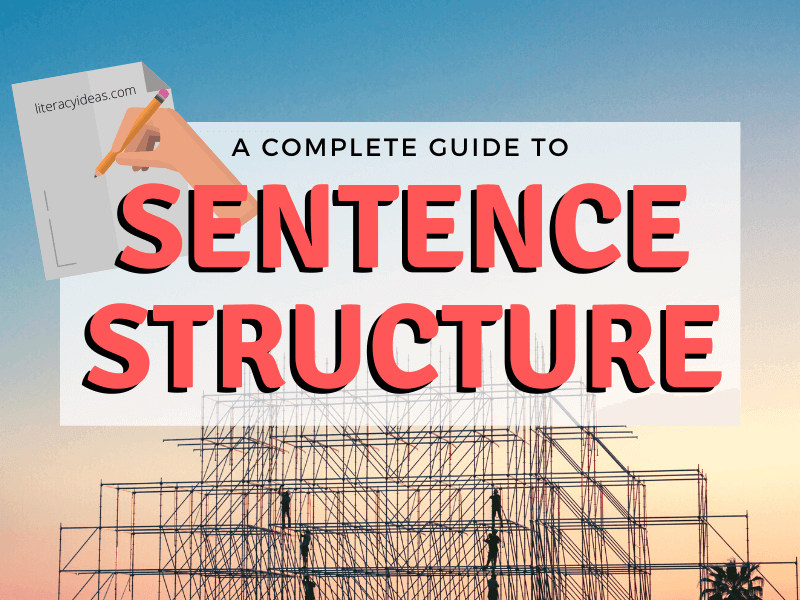
Once the student-writer has effectively expressed their opinion on a matter, they then will need to provide the reader with the reasons for why they think what they think. In an essay, these reasons will usually be found in the body paragraphs or development paragraphs. Normally, these paragraphs will explore a single reason each.
Some helpful sentence starters for introducing these reasons include:
● One reason I feel this way is…
● Evidence to support this can be found in…
● I believe this to evident in…
Opinion Writing Activities for Students
Students will certainly need practice completing sustained pieces of opinion writing, but some of the most valuable activities to help students evolve their opinion writing abilities barely require a pen to be put to paper.
While the following two activities do not require students to engage in extended pieces of writing, the activities below will assist students in grasping some essential concepts. These activities demonstrate good practice through modelling and also encourage dialogue, discussion, and debate as a means to strengthen opinion writing.
Activity 1: Opinion Writing – What Is It?
This exercise is a good follow-up to introductory work outlining the criteria of opinion writing as described above.
● Start by passing out copies of a piece of opinion writing you have selected to read with the class. Read the text aloud as the students follow along with their copy. The opinion text chosen can come from a wide range of genres, including advertisements, letters, editorials, essays, articles, or reviews.
● Assign students a talking partner and instruct students to take five minutes to identify the various criteria employed in the text. Encourage students to mark and annotate their copies of the text accordingly. You may even wish to supply students with a checklist compiled from the criteria mentioned previously in this article.
● As a whole class, discuss how successfully the text fulfills the criteria. What did the writer do well? What could they have done better? You can record their responses on the whiteboard.
The aim of this exercise is for students to hone their critical faculties while internalizing the criteria. This will reap rewards when the students later engage in their own extended opinion writing.
Activity 2: The Collaborative Case
This activity employs collaboration to help students build a stronger case for their opinion on a divisive issue.
● First, define the parameters of the exercise by presenting an either/or conundrum to the class. This doesn’t have to be overly controversial in nature, just stated in such a way that it forces the students to take one side or another. This could be stated simply as a choice, e.g. Dogs or cats? City or countryside? Beach or Mountains? Sweet or savory?
● Students then divide into two groups according to their stated preferences. In their groups, they then discuss and compile as many supporting reasons for their choice as they can come up with. As a group, they will discuss the relative merits of each reason, before agreeing on their top five.
● The groups then share their reasons in a debate format, using arguments and counter-arguments, leading into an open, free-ranging discussion.
The value of this exercise lies in the collaborative and ‘combative’ natures of the exercises. Just as our physical muscles can grow through resistance, so too can the strength and resilience of our opinions and arguments.
This activity can also be used as a lead-in to opinion writing as it works well as a prewriting preparation exercise. The complexity of the issue to be discussed and debated can easily be modified to suit the abilities of the students too.
A COMPLETE UNIT ON TEACHING FIGURATIVE LANGUAGE

❤️The use of FIGURATIVE LANGUAGE is like “SPECIAL EFFECTS FOR AUTHORS.” It is a powerful tool to create VIVID IMAGERY through words. This HUGE 110 PAGE UNIT guides you through a complete understanding of FIGURATIVE LANGUAGE as both a READER and WRITER covering.
OPINION WRITING VIDEO TUTORIALS
These videos from teaching without frills are an excellent starting point for opinion writing. You can view the entire collection here.
The Wrap Up
Opinion writing is a higher-level skill that makes many demands on our students. It will challenge them to move beyond parroting the facts and figures they have acquired in their learning to formulate their own thoughts on topics they have learned about in class, or in the wider world beyond the school gates.
It will make demands on their skill as writers too. Our students must learn to mold and mechanically manipulate the language on the page to express their beliefs persuasively and effectively. To do this successfully, they will need ample opportunities to practice their writing craft. Once a firm understanding of the structures involved has been established, the student can become more fluid in their expression. They will add art and flair to their craft. But first, they must build on these firm foundations.
OTHER GREAT ARTICLES RELATED TO OPINION WRITING

Top 5 Persuasive Writing Techniques for Students

5 Top Persuasive Writing Lesson Plans for Students and Teachers

How to Write Perfect Persuasive Essays in 5 Simple Steps

23 Persuasive writing Topics for High School students
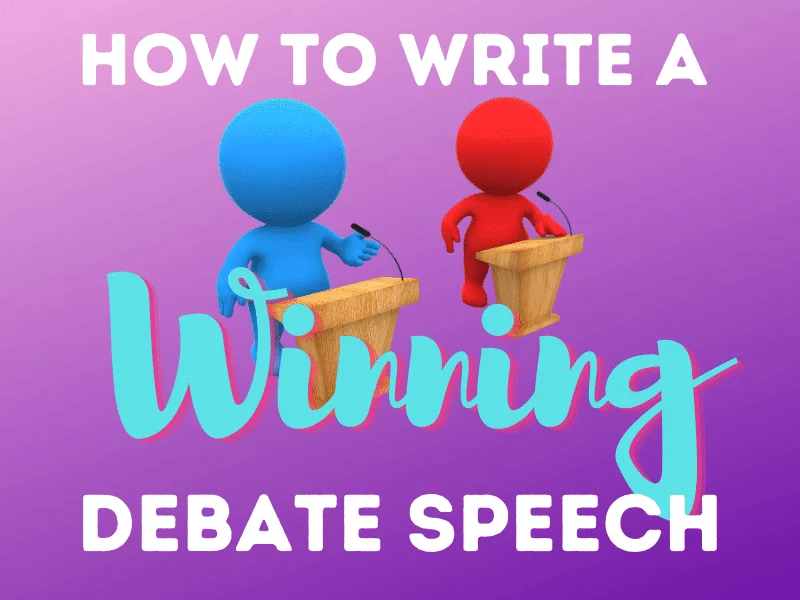
How to Write a Winning Debate Speech
Opinion Writing: a Guide to Writing a Successful Essay Easily

An opinion essay requires students to write their thoughts regarding a subject matter. Relevant examples and explanations back their point of view. Before starting an opinion paper, it is important to study the definition, topics, requirements, and structure. Referring to examples is also highly useful. Perhaps you need help with our admission essay writing service ? Take a look at this guide from our dissertation writing service to learn how to write an opinion essay like an expert.
What Is an Opinion Essay
A common question among students is: ‘What is an Opinion Essay?' It is an assignment that contains questions that allow students to share their point-of-view on a subject matter. Students should express their thoughts precisely while providing opinions on the issue related to the field within reasonable logic. Some opinion essays type require references to back the writer's claims.
Opinion writing involves using a student's personal point-of-view, which is segregated into a point. It is backed by examples and explanations. The paper addresses the audience directly by stating ‘Dear Readers' or the equivalent. The introduction involves a reference to a speech, book, or play. This is normally followed by a rhetorical question like ‘is the pope Catholic?' or something along those lines.
What Kind of Student Faces an Opinion Essay
Non-native English-speaking students enrolled in the International English Language Testing System by the British Council & Cambridge Assessment English are tasked with learning how to write the opinion essays. This can be high-school or college students. It is designed to enhance the level of English among students. It enables them to express their thoughts and opinions while writing good opinion essay in English.
Get Your Opinion ESSAY READY TODAY!
We will write you a plagiarism-free opinion essay, with a title page, unlimited revisions, and bunch of other cool features included!
What Are the Requirements of an Opinion Essay?

Avoid Going Off-Topic: Always write an opinion essay within relevance to answer the assigned question. This is also known as ‘beating around the bush' and should not be included in any opinion paragraph as it may lower your grade.
Indent the First Paragraph: With most academic papers, opinion writing is not different. Therefore, it contains the rule of indenting the first line of the introduction.
A Well-Thought Thesis: The full thesis statement is a brief description of the opinion essay. It determines the rest of the paper. Include all the information that you wish to include in the body paragraphs
The Use of Formal Languages: Although it is okay to write informally, keep a wide range of professional and formal words. This includes: ‘Furthermore,' ‘As Stated By,' ‘However', & ‘Thus'.
Avoid Internet Slang: In the opinion paper, avoid writing using slang words. Don'tDon't include words like ‘LOL', ‘OMG', ‘LMAO', etc.
The Use of First Person Language (Optional): For the reason of providing personal thought, it is acceptable to write your personal opinion essay in the first person.
Avoid Informal Punctuation: Although the requirements allow custom essay for the first-person language, they do not permit informal punctuation. This includes dashes, exclamation marks, and emojis.
Avoid Including Contradictions: Always make sure all spelling and grammar is correct.
We also recommend reading about types of sentences with examples .
Opinion Essay Topics
Before learning about the structure, choosing from a wide range of opinion essay topics is important. Picking an essay theme is something that can be done very simply. Choosing an excellent opinion essay topic that you are interested in or have a passion for is advisable. Otherwise, you may find the writing process boring. This also ensures that your paper will be both effective and well-written.
- Do sports differ from ordinary board games?
- Is using animals in circus performances immoral?
- Why should we be honest with our peers?
- Should all humans be entitled to a 4-day workweek?
- Should all humans become vegetarians?
- Does a CEO earn too much?
- Should teens be barred from having sleepovers?
- Should everyone vote for their leader?
- The Pros & Cons of Day-Light Saving Hours.
- What are the most energy-efficient and safest cars of X year?
Opinion Essay Structure
When it comes to opinion paragraphs, students may struggle with the opinion essay format. The standard five-paragraph-essay structure usually works well for opinion essays. Figuring out what one is supposed to include in each section may be difficult for beginners. This is why following the opinion essay structure is something all beginners should do, for their own revision before writing the entire essay.
You might also be interested in getting more information about: 5 PARAGRAPH ESSAY

Opinion essay introduction
- Address the audience directly, and state the subject matter.
- Reference a speech, poem, book, or play.
- Include the author's name and date of publication in brackets.
- 1 or 2 sentences to make up a short description.
- 1 or 2 summarizing sentences of the entire paper.
- 1 sentence that links to the first body paragraph.
Body Paragraph 1
- Supporting arguments
- Explanation
- A linking sentence to the second body paragraph.
Body Paragraph 2
- Supporting argument
- A linking sentence to the third body paragraph.
Body Paragraph 3
- A linking sentence to the conclusion.
Conclusion paragraph
- Summary of the entire paper
- A conclusive sentence (the bigger picture in conclusion)
If you need some help, leave us a message ' write my essay cheap ' and we'll help.
Opinion Essay Examples
Do you need something for reference? Reading opinion essay examples can expand your knowledge of this style of writing, as you get to see exactly how this form of an essay is written. Take a look at our samples to get an insight into this form of academic writing.
Over the past, American popular culture has been strong in creating racial stereotypes. Images displayed through television, music, and the internet have an impact on how individuals behave and what individuals believe. People find their identities and belief systems from popular culture. Evidently, I believe that American pop culture has created racial stereotypes that predominantly affect other ethnic minorities. Analyzing the history of America reveals that African Americans have always had a problem defining themselves as Americans ever since the era of slavery. AfricanAmericans have always had a hard time being integrated into American culture. The result is that African Americans have been subjected to ridicule and shame. American pop culture has compounded the problem by enhancing the negative stereotypes ofAfrican American. In theatre, film, and music, African Americans have been associated with vices such as murder, theft, and violence.
The family systems theory has a significant revelation on family relations. I firmly agree that to understand a particular family or a member, they should be around other family members. The emotional connection among different family members may create functional or dysfunctional coexistence, which is not easy to identify when an individual is further from the other members. Taking an example of the extended family, the relationship between the mother-in-law and her daughter-in-law may be tense, but once they are outside the family, they can pretend to have a good relationship. Therefore, I agree with the theory that the existing emotional attachment and developed culture in the family is distinctively understood when the family is together.
Opinion writing is a form of academic paper that asks students to include their thoughts on a particular topic. This is then backed by a logical explanation and examples. Becoming more knowledgeable is a practical way to successfully learn how to write an opinion paper. Before writing anything, it is essential to refer to important information. That includes the definition, topics, opinion writing examples, and requirements. This is what turns amateur writers into master writers.
Feeling like you need some assistance with your essay? No matter what kind of writer you need, opinion or persuasive essay writer , our team consists of experts in all fields. Our college essay writing service helps those students who need an extra push when it comes to their assignments.
Need Qualified Essay Help?
Are you struggling with your opinion paper? Hit the button below to get writer's help. All your requests are processed fast.
Related Articles
.webp)

Language & Grammar

Science & Social Studies

Digital Learning
Teaching opinion writing tips and activities.

Today, you’re going to get a bunch of teaching opinion writing tips. I’m going to what best practices I think you can follow. I hope that you’re going to walk away with a clear understanding of what is expected when teaching this standard. I also hope you walk away with some fun ideas and activities to add to your lesson plans! All of the images you see below (except for the read-alouds) are part of my ELA writing units. The links to all grade levels are at the bottom!
Let’s dive into the opinion writing standards
Common Core writing domain focuses on three big types of writing: informative, narrative, and today’s topic OPINION WRITING! It begins kindergarten and each year, gets progressively more in depth and detailed. Here is a look at K-5’s expectations for opinion writing, according to Common Core.
- Kinder: Use a combination of drawing, dictating, and writing to compose opinion pieces in which they tell a reader the topic or the name of the book they are writing about and state an opinion or preference about the topic or book (e.g., My favorite book is.. .).
- 1st: Write opinion pieces in which they introduce the topic or name the book they are writing about, state an opinion, supply a reason for the opinion and provide some sense of closure.
- 2nd: Write opinion pieces in which they introduce the topic or book they are writing about, state an opinion, supply reasons that support the opinion, use linking words (e.g., because , and , also ) to connect opinion and reasons, and provide a concluding statement or section.
- 3rd: Write opinion pieces on topics or texts, supporting a point of view with reasons. (a- Introduce the topic or text they are writing about, state an opinion, and create an organizational structure that lists reasons.) (b- Provide reasons that support the opinion.) (c- Use linking words and phrases (e.g., because , therefore , since , for example ) to connect opinion and reasons.) (d- Provide a concluding statement or section.)
- 4th: Write opinion pieces on topics or texts, supporting a point of view with reasons and information. (a- Introduce a topic or text clearly, state an opinion, and create an organizational structure in which related ideas are grouped to support the writer’s purpose.) (b- Provide reasons that are supported by facts and details.) (c- Link opinion and reasons using words and phrases (e.g., for instance , in order to , in addition ).) (d- Provide a concluding statement or section related to the opinion presented.)
Outline of how to teach opinion writing…
- What is opinion writing?
- How do I state an opinion?
- Supporting your opinion
- Introductions explicit teaching
- Conclusions explicit teaching
- Provide lots of practice
If you teach opinion writing broken up in parts like this, your students can focus on each part. That way, they can get a true grasp of what each piece requires and how to write it.
Load up on Mentor Texts

Every single part of this blog post will include mentor texts. Each time you teach your students about a component of opinion writing, use a strong example! Mentor texts are great because students can see what they’re learning in engaging or familiar books. Then, it can help them with their own practice. Each of the book links below are affiliate links to Amazon.
- Hey Little Ant by Phillip and Hannah Hoose
- I Don’t Want to Be a Frog by Dev Petty
- My Teacher for President by Kay Winters
- The Perfect Pet by Margie Palatini
- I Wanna New Room by Karen Kaufman Orloff
- I Wanna Iguana by Karen Kaufman Orloff
- The True Story of the Three Little Pigs by Jon Scieszka
- The Day the Crayons Quit by Drew Daywalt
- Red is Best by Kathy Stinson
- Earrings by Judith Viorst
- Don’t Let Pigeon Drive the Bus! by Mo Willems
- Click, Clack, Moo by Doreen Cronin
First, teach WHAT Opinion Writing is

When you begin your opinion writing unit, you of course need to start with teaching them what it is. You will be showing them the framework of an opinion writing piece. First, create an anchor chart (or use one provided to you in my ELA units). Then, as you explore texts, examples, and activities, you can refer back to this anchor chart to teach opinion writing framework.

Now, it’s time to get the students talking. Give them an engaging partner talk game, such as Stand Up, Hand Up, Pair Up or Mix-Pair-Share. When they’re with a partner, ask them questions about the actual framework. Ask them the purposes of each component. This will help strengthen their writing when it’s time to start writing independently.

After that, you can start showing them real-world examples. Start with read-alouds and mentor texts. See if students can identify the introduction, opinion sentence, support, and conclusion. Then, give them examples that aren’t tied to a picture book. Above, you see two different activities. One of them asks students to put a puzzle together of sample sentences for each component. The other is a cut-and-glue activity where they have to sort sample sentences. (Links to all resources are at the bottom of the blog post.)
Stating an Opinion

Next, it’s time to simply teach them how to state an opinion. If you’re in kinder or first grade, you may have to take a step back and teach what an opinion is and how it’s different from a fact. But… once that’s determined, you can start teaching opinion sentences.
Make a class anchor chart or display a stem poster in your classroom. This will help trigger their ability to form an opinion sentence. Then, give them a few engaging partner activities. For example, the image above shows a partner game where students are shown an Opinion Stem chart and one picture topic card at a time. They will form an opinion sentence about that topic using a different stem each time.

It’s also important to teach your writers the difference between strong and weak opinion sentences. There is a big difference between “I like pizza” and “Pizza is my favorite dinner”. One way to practice this is to have students sort different sample sentences into the strong and weak categories.
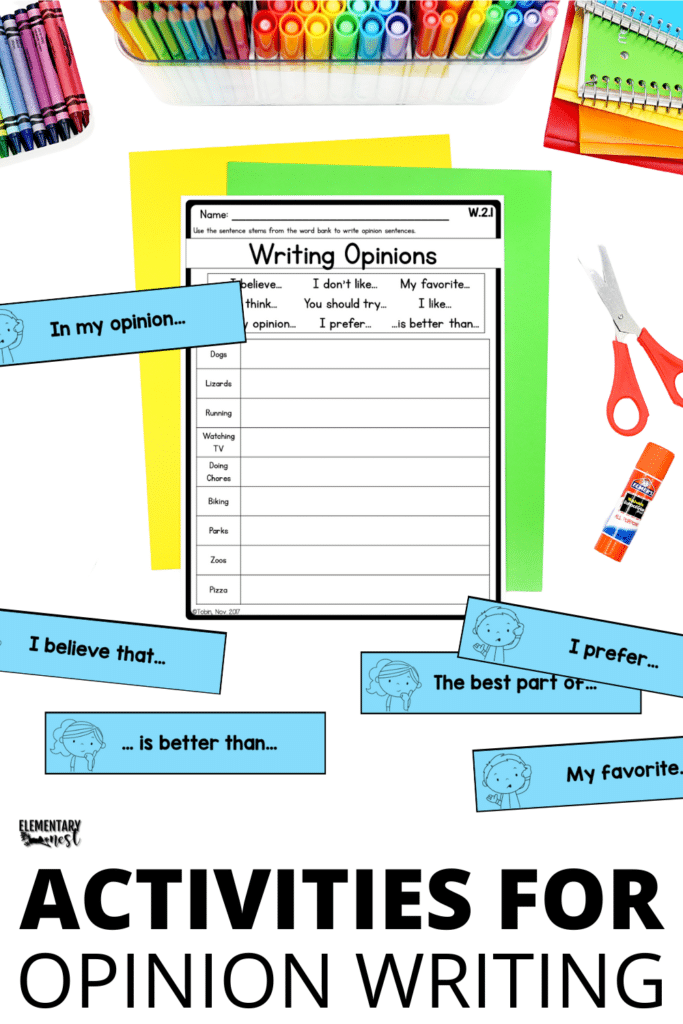
Then, it’s time to let them practice! Try using one of the templates in the ELA unit like the one shown above. It gives students a collection of sentence stems and a topic. They will have to form an opinion sentence using a mixture of all these options!
Dive deeper with reasons

Once you get into second, third, fourth grade (and above), you’re going to be required to teach students how to support their opinion. The big thing that can really help is just the word ‘why’. This helps trigger students to think of the reasons behind their opinion. Once they get to 2nd grade, they have to be able to give reasons why they like or dislike something. Try using an opinion writing anchor chart explaining support.

Now that you’ve taught your students HOW to support their reasons, it’s time to practice. Give them lots of opportunities to try supporting opinions with reasons. There are two activities shown in the image above. First, you have a picture card with an opinion sentence. Students will work with a partner to try to create a strong reason to support this opinion. Next, there is an opinion sentence strip that students will draw and try to create a strong support.
Move onto INTRODUCTIONS when teaching opinion writing

One of the biggest pieces to teaching opinion writing is the introduction. This is the hook. This is where your students are going to try to draw their audience in. First, teach introductions explicitly using an anchor chart or poster from my ELA units. Then, choose one or two mentor texts to show how they’ve used introductions to hook their readers.

It’s a great idea to show students what a strong introduction looks like with modeling. Another way is to give them a matching activity where they have to read introduction sentences and sort them.

Here is another game example for students to participate in. They will match three cards together. First, they will match the topic card and a sample introduction. Then, they will match a strong opinion sentence to follow up their introduction sentence. While playing this game, students can get a strong sense of what an introduction paragraph will look like in a multi-paragraph paper.
Finish up with CONCLUSIONS

Next, you’ll teach conclusions explicitly. Just like you did with introductions, conclusions need to start with an anchor chart or discussion of a poster. Students can learn conclusion stems, reasons for conclusions, and why they’re used. After teaching opinion writing conclusions explicitly, show students examples with mentor texts from the list above. Read one or two mentor texts and discuss what conclusions were used.

Give your students lots of practice with writing conclusions. Hands-on writing activities and matching games are two ways to give them practice singling out conclusions. Above, you see a flip book. They will fold and snip along the dotted edges. Under each flap, students will write an example of each type of conclusion (such as final facts, repeated opinions, personal experiences, and offering a suggestion.
Provide lots of opportunities to practice!

In my ELA units, I also offer 3-4 final writing pieces. They’re presented as lesson plans, so you can still walk students through these steps. First, they’ll be presented with their prompt. The prompt shown above asks which living condition would be worse: Arctic or desert. Then, the steps of the lesson plans walk students through brainstorming, pre-writing, and drafting their papers.

Finally, you’ve taught all the pieces of your opinion writing unit. Therefore, it’s time to practice, practice, practice. Once you teach students to write an opinion piece from start to finish, give them different prompts to write about in their journals. Or they could even write about these as a final opinion writing piece! Choose high-interest and engaging topics for students to write about.
Are you ready for your Opinion Writing resources?

Interested in Free Graphic Organizers for Your Writing Unit?
Want to read more writing blog posts?
- How to Make Your Writing Interactive
- Warm Up Your Kids with a Daily Writing Warm-up
- Read more about: Common Core Aligned , Writing Blog Posts
You might also like...

3 Easy Times to Squeeze Speaking and Listening Skills into Your Day
In today’s blog post we will talk about incorporating speaking and listening skills in your elementary classroom! Finding time to focus on these crucial skills

Introduction to Fractions: Partitioning, Shares, and Fractions in 1st and 2nd Grade
Hello teachers! Welcome to today’s blog post, where we will dive into the fascinating world of fractions, tailored specifically for 1st and 2nd-grade classrooms. Fractions

Teaching Text Features in the Spring
This isn’t the first time we’ve discussed using the current season as a way to make your ELA content more engaging. Adding the element of
Join these happy teachers
Join the email list.
Get teaching tips, how-to guides, and freebies delivered right to your inbox every Wednesday!
Hi, I'm Jessica

I help elementary teachers master the standards by providing helpful standards-based tips, guides, and resources.

Let's Connect
Access your purchases
© Elementary Nest • Website by KristenDoyle.co


How to Teach Opinion Writing
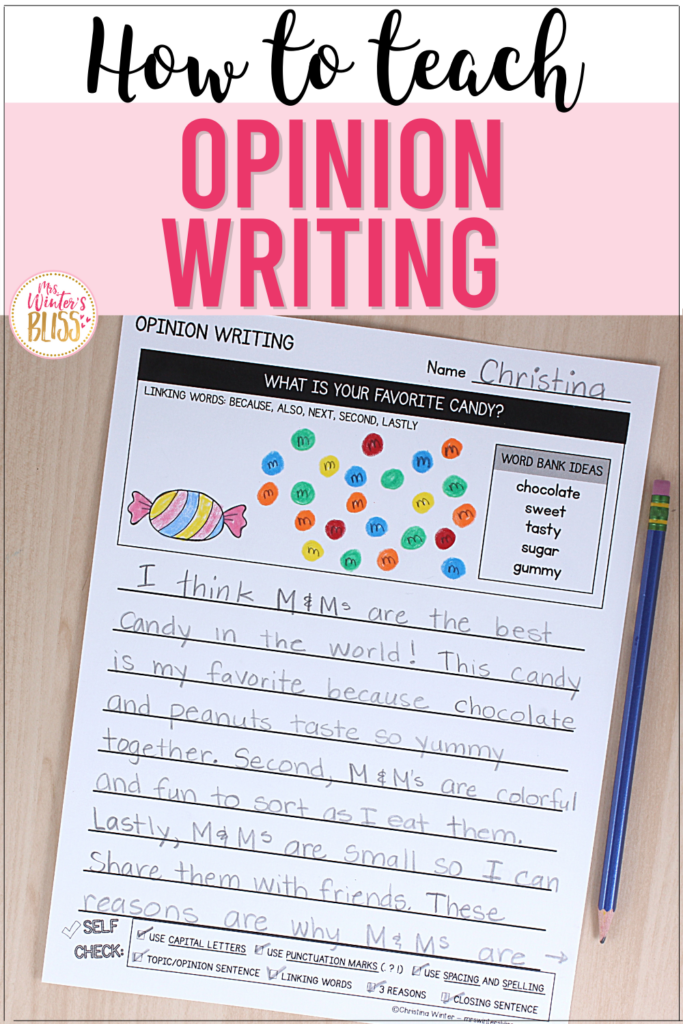
In this post, I share 5 tips for How to Teach Opinion Writing and provide details about the Opinion Writing Units resources I have created for Kindergarten, 1st and 2nd grade students. Be sure to download 3 FREE opinion writing graphic organizers !
The Common Core writing domain focuses on three big types of writing: informative, narrative, and opinion writing. Each genre serves a unique purpose and follows a specific structure in which we must explicitly teach our students. In my last post I shared tips and resources for teaching Informative Writing and today I’m excited to move on to Opinion Writing.
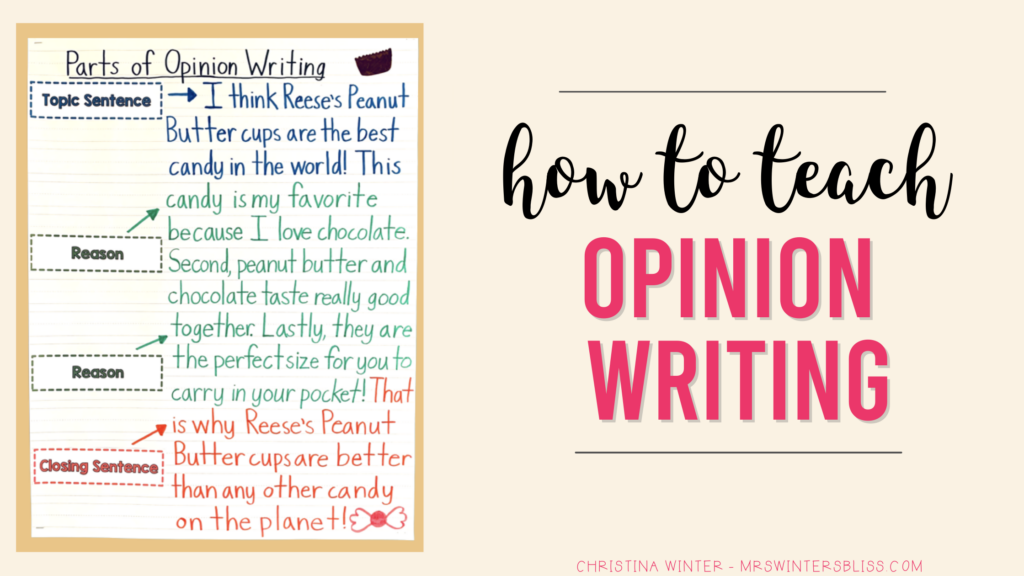
Opinion Writing is one of my favorite genres to teach. Young students have opinions on just about EVERYTHING and they usually aren’t afraid to share them!! For this reason, they find the genre highly engaging!
Today I’m sharing 5 tips for teaching opinion writing, as well as a valuable resource that has everything you need to bring opinion writing into your kindergarten , first grade, or second grade literacy centers!
Tips for Teaching Opinion Writing
1. read opinion writing mentor texts .
Before you can ask your students to write in a genre that is new to them, you must first immerse them in it. So to begin your unit, you’ll want to share examples of opinion writing with your students. These mentor texts provide students with excellent examples of opinion writing.
As you read them aloud, highlight the way the author structures their writing. Identify the author’s topic or opinion and point out the reasons he or she gives to support their opinion. All of these things will help students better understand what type of writing we are asking them to do.
When you’re picking opinion mentor texts to share with your students there are a few things to consider . First, do you (the educator) think it is excellent? Second, is it easy for your students to understand? And finally, is it relevant to the type of writing you are teaching? If you answer “Yes!” to all three, then you’re good to go!
To help you out I’ve created a list of excellent mentor texts you can use when teaching opinion writing to kindergarten, first, or second grade students.
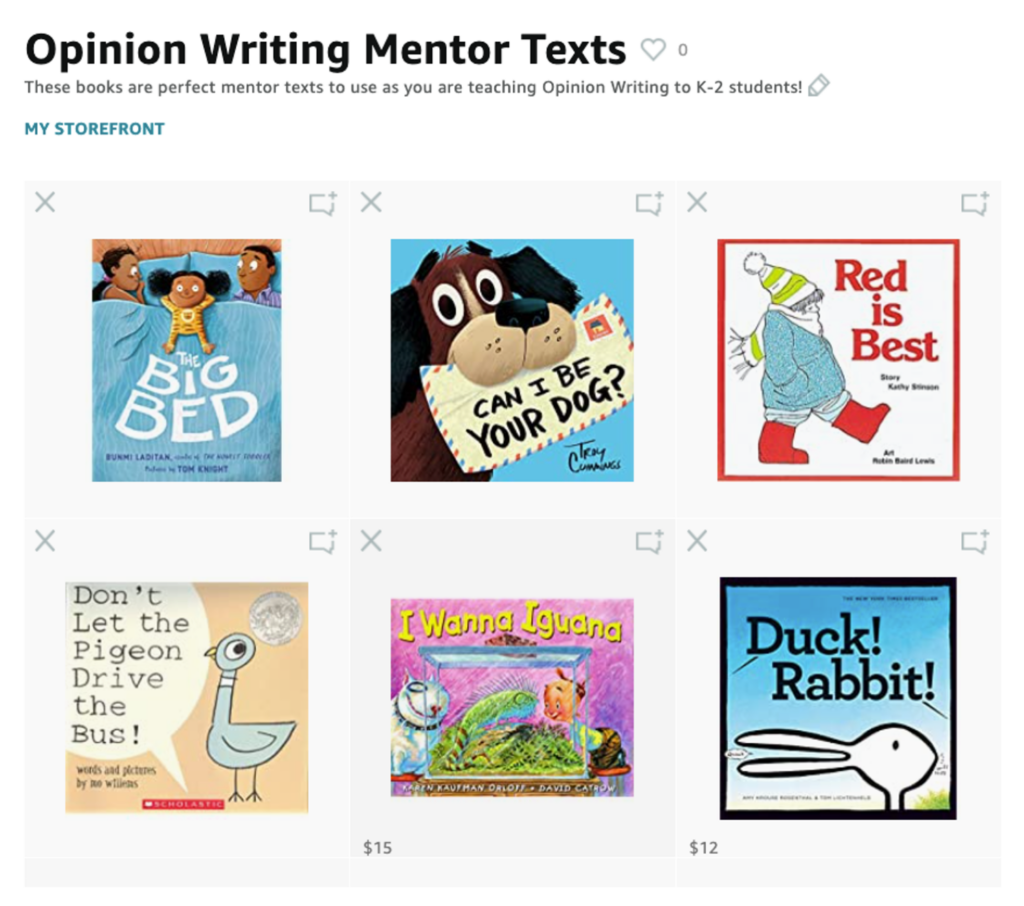
A List of Opinion Writing Mentor Texts:
- Duck Rabbit by Amy Krouse Rosenthal
- I Wanna Iguana by Karen Kaufmann Orloff
- Don’t Let the Pigeon Drive the Bus by Mo Willems
- Red is Best by Kathy Stinson
- Can I Be Your Dog? by Troy Cummings
- The Big Bed by Bunmi Laditan
I’ve saved all these titles on one board so you can easily take a closer look at these mentor texts. Click here to see this list on Amazon.
2. Model Your Own Opinion Writing
I know I say this a lot, but it’s worth repeating…. MODEL, MODEL, and then once again MODEL what you expect your students to do! It is a tremendously powerful instructional tool!
When teaching opinion writing you’ll first model how to choose a topic. When you generate ideas you can ask yourself, “What do I know all about?” “What do I care about?” “What do I wish other people believed?”.
If these questions feel too broad for your students you can use simple “would you rather” questions to get your ideas for an opinion piece. For example, “Would you rather have a dog or a cat?” This could lead to the topic, “Dogs are the best pet.” Keep it simple and choose a topic that is relatable to your students.
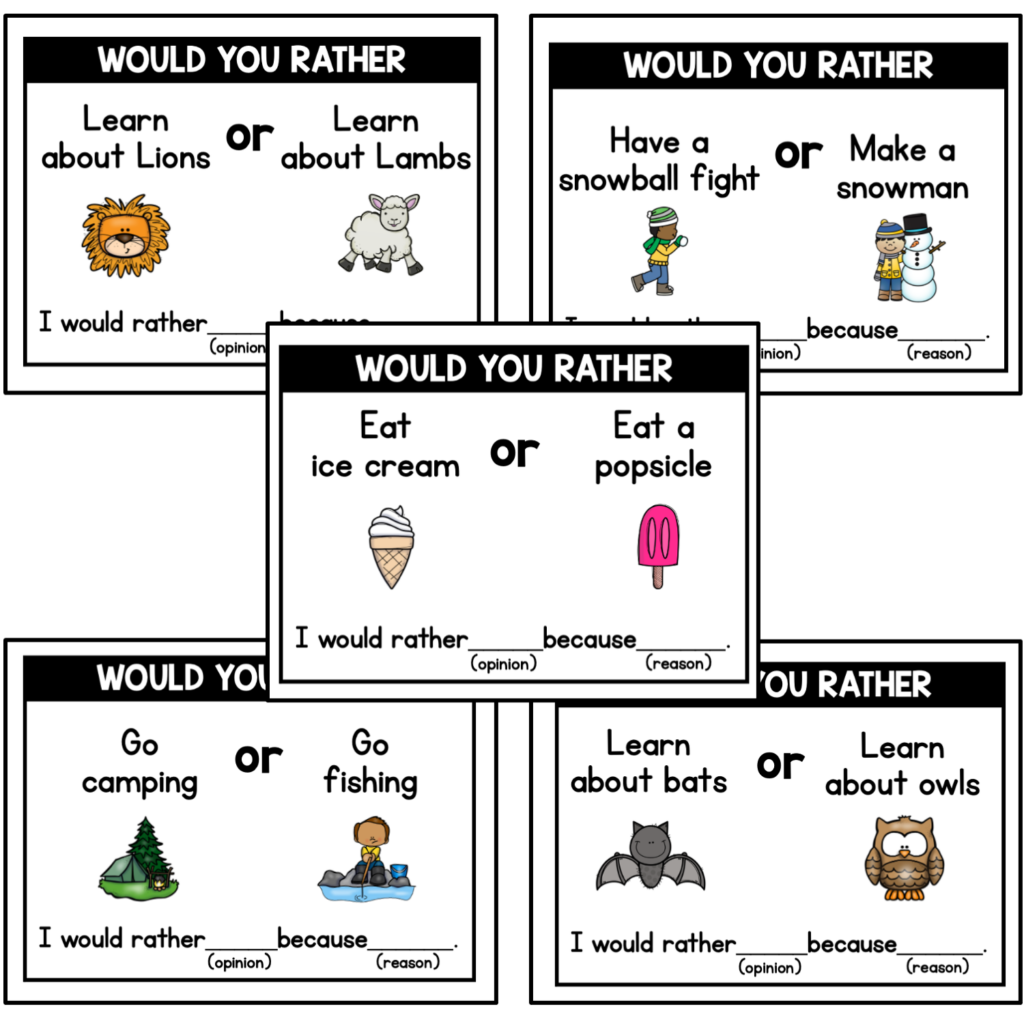
Next, model how you plan your writing using a graphic organizer. Show them how you open with a topic sentence that states your opinion. Next, come up with your supporting reasons. End with a closing sentence that restates your opinion.
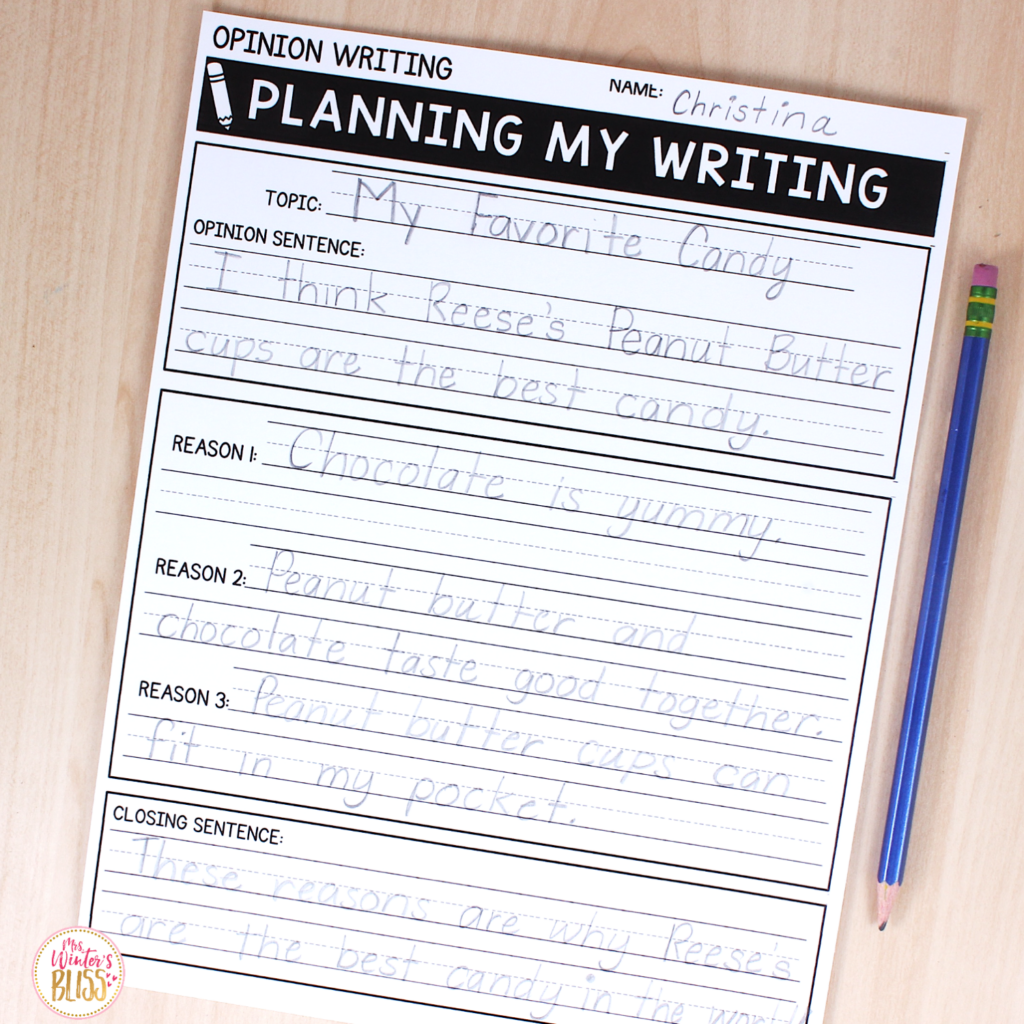
Model how you use the graphic organizer to guide you as you write out your full piece.
Finally, reread your work aloud and show students how you catch silly mistakes such as spelling, capitalization or punctuation errors. You can also show how you add additional supporting reasons to make your writing more persuasive to the reader.
3. Use Anchor Charts
You want your students to know that when they write an opinion piece they are sharing their own opinion. They are not sharing true facts. Take time to review the difference between facts and opinions. Create an anchor chart that defines fact vs. opinion.
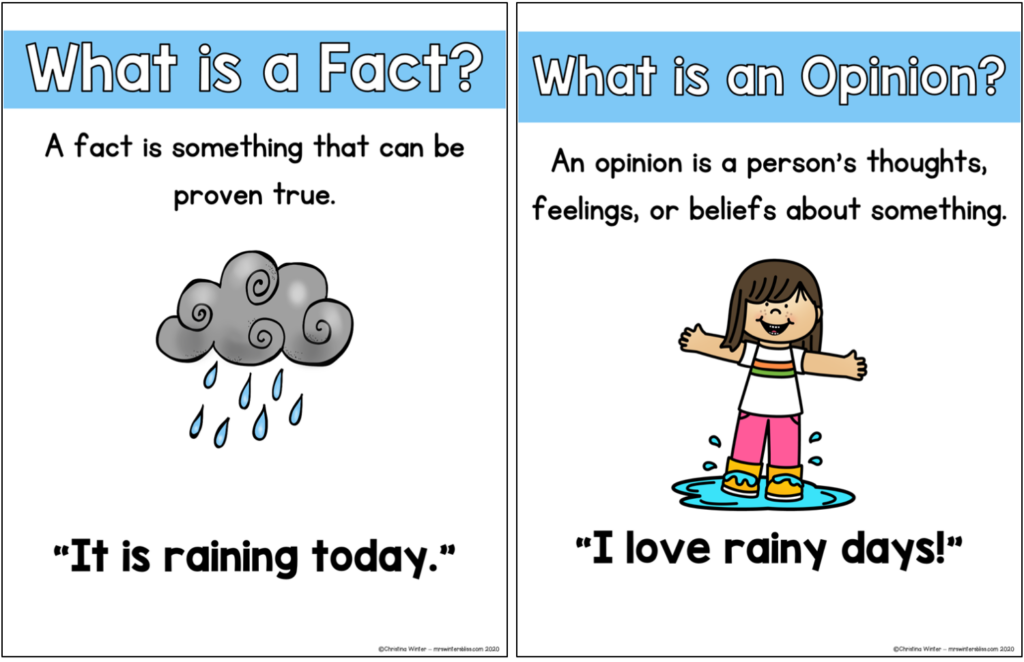
You’ll also want to review language that is specific to the genre. Remind students of the linking or transitional words that connect their opinion to their reasons.
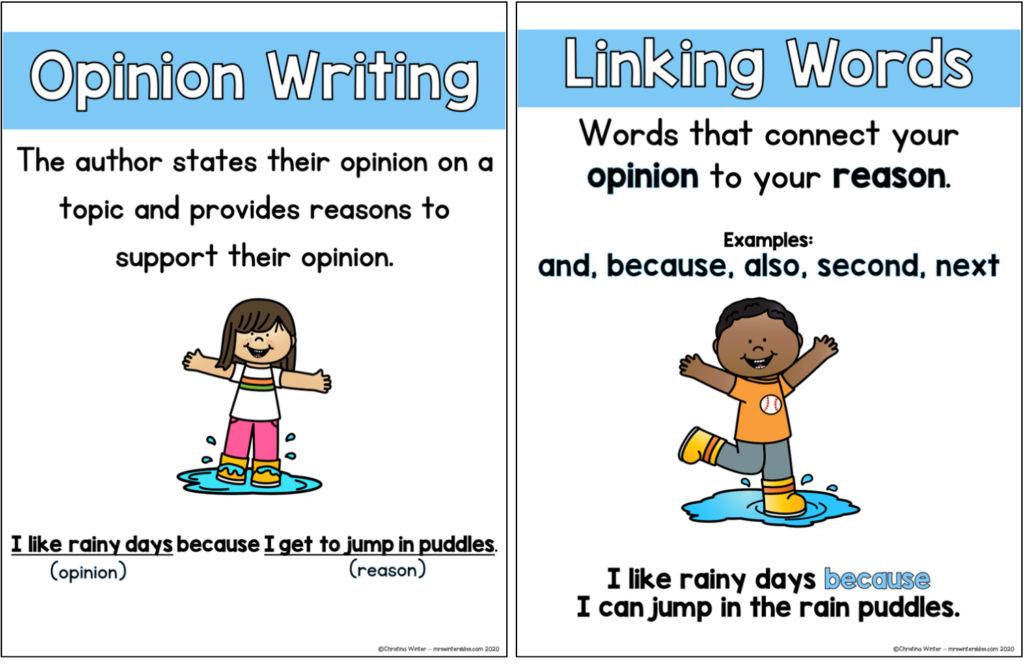
Finally, you’ll want to create an anchor chart using the writing you model. This will serve as another example of excellent opinion writing. As a class, add labels to identify the topic sentence, supporting reasons and the closing sentence in your shared writing.
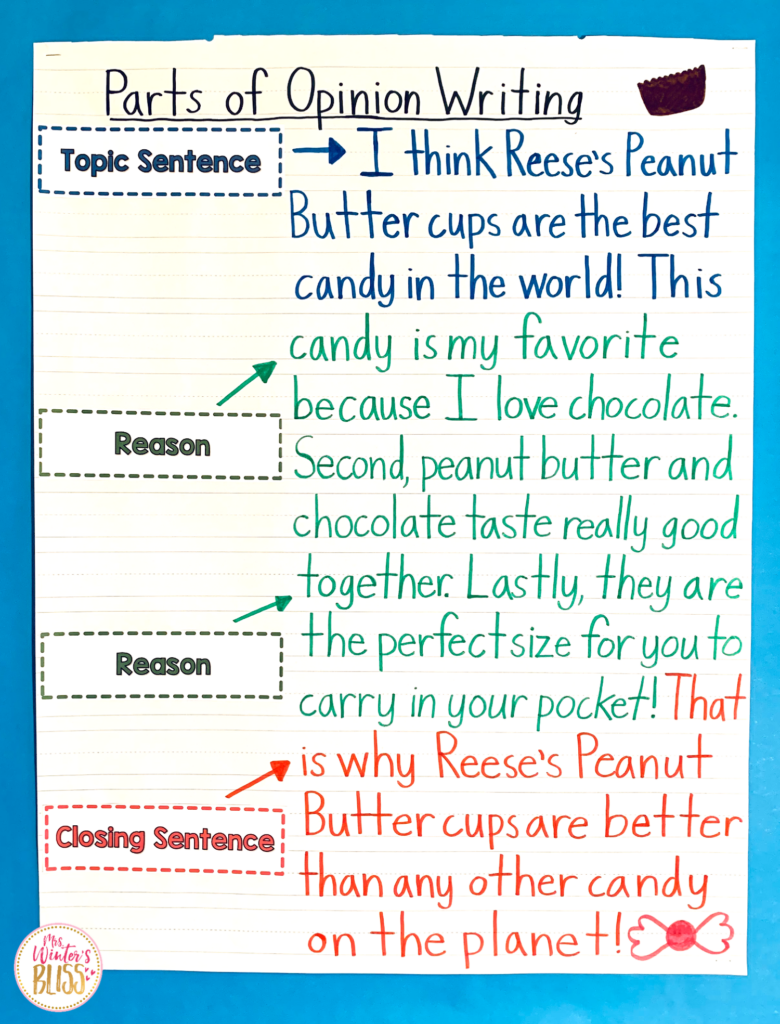
All of these anchor charts can be posted in your writing center. Encourage your students to refer back to them and use them as support as they write their own pieces.

4. Allow students to edit and share their writing
Provide a good writers checklist at your writing center. For opinion writing you’ll want the checklist to include items such, “Do I have a topic sentence that clearly states my opinion?” “Do I have supporting reasons ?” and “Do I have a closing sentence?”, as well as reminders to check for spelling, capitalization, and punctuation errors.
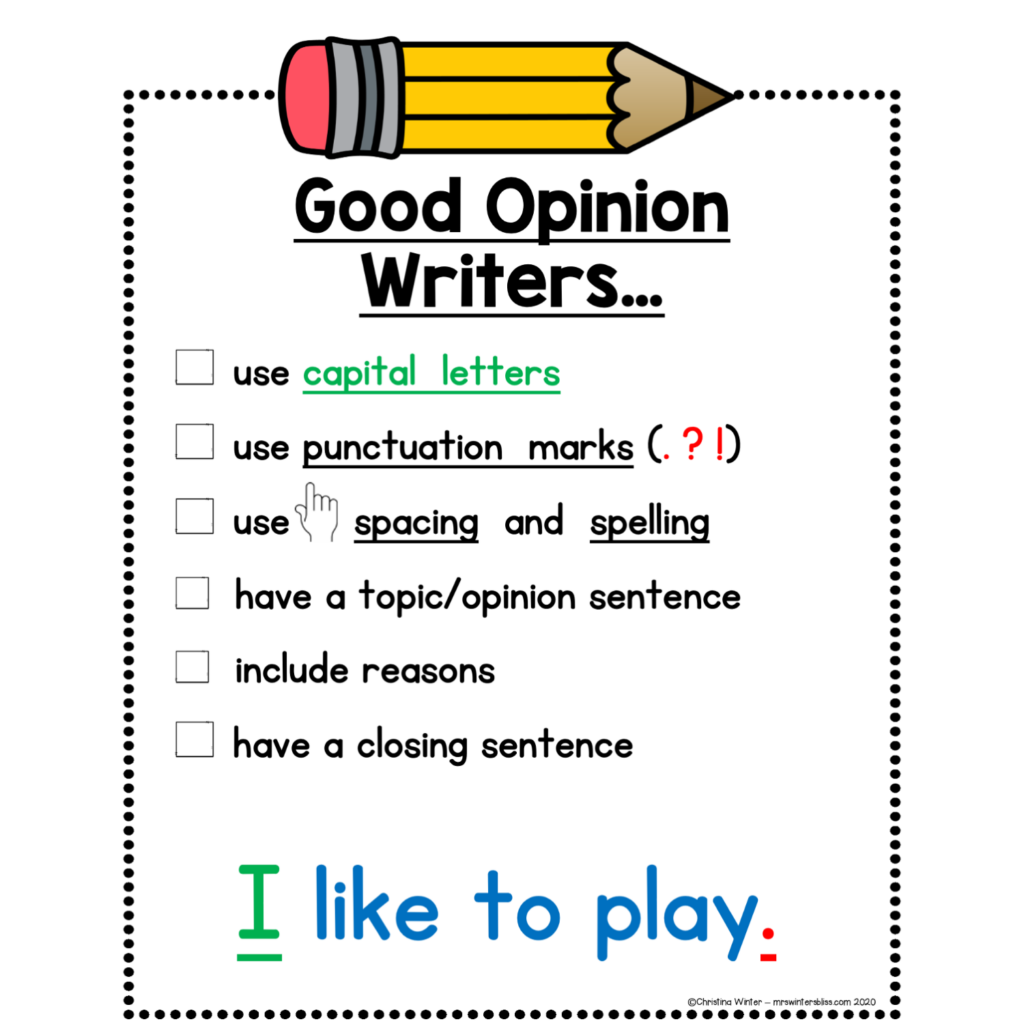
You can also create a rubric specific to the genre. Model how you use it to assess your own work and how it can be used to provide feedback to others.
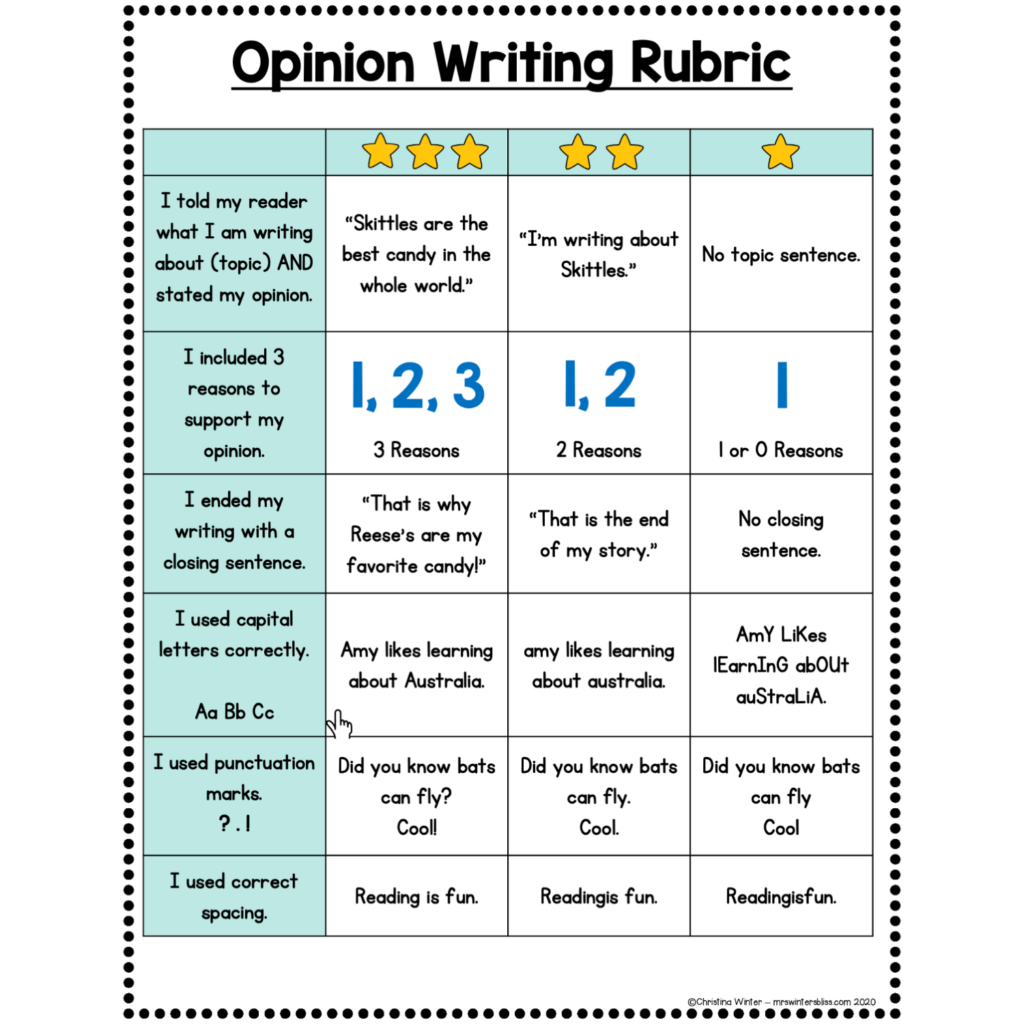
Give students the opportunity to share their writing with others! Pair students with partners and let them read their pieces to each other. Encourage them to provide feedback using the editing checklist and the rubric as a guide.

5. Provide Daily Opportunities for Students to Write
As with all things, writing takes PRACTICE! Students need dedicated instructional time to learn the skills and strategies necessary to become effective writers, as well as time to practice what they learn. When you think about your daily instructional schedule, make sure you are giving your students ample opportunities to practice their opinion writing through whole-group instruction, small groups and/or independent practice in writing centers.
Opinion Writing Unit For Kindergarten, First, and Second Grade Students
Today I’m excited to share with you the details about my Kindergarten Opinion , 1st Grade Opinion , and my 2nd grade Opinion Writing units! I love them because they have ALL the resources you need to give your students the practice they need to master opinion writing.
These units were developed with standards-based research specific to each grade. You can use them within whole class or small group instruction, or as a literacy center activity where students can practice opinion writing independently!
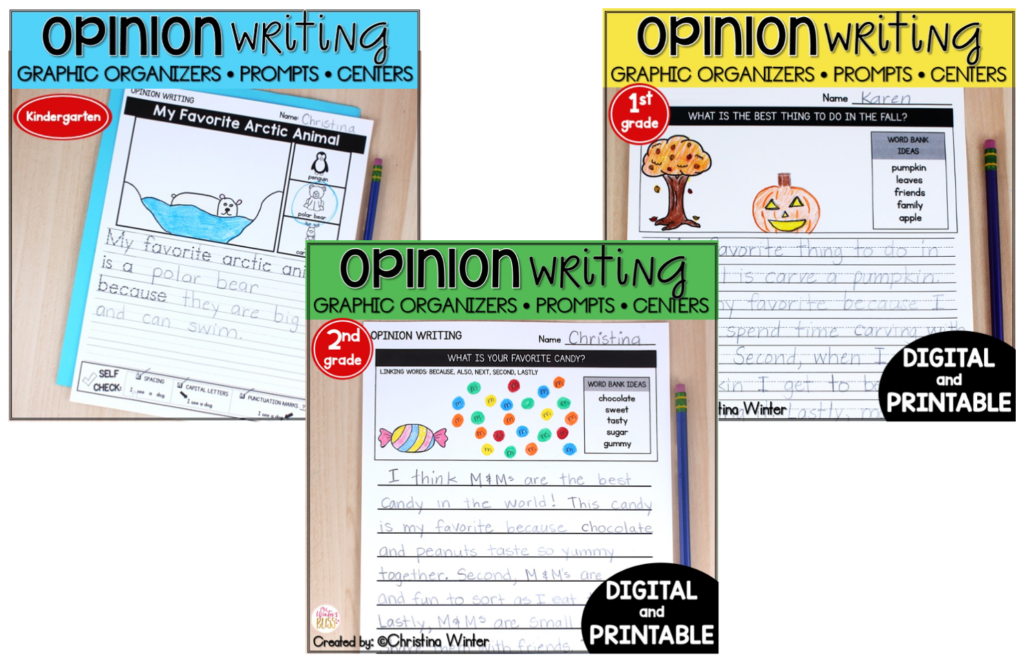
What’s Included in these Opinion Writing Resources?
The kindergarten , first grade , and the second grade opinion writing resources each include information to help you unpack the unit and a mini-lesson you’ll teach to give your students a review of opinion writing. You’ll get a list of suggested mentor texts and online resources, printable anchor charts, graphic organizers, seasonal writing prompts, and conversational task cards to help get kids to share their opinion on different topics.
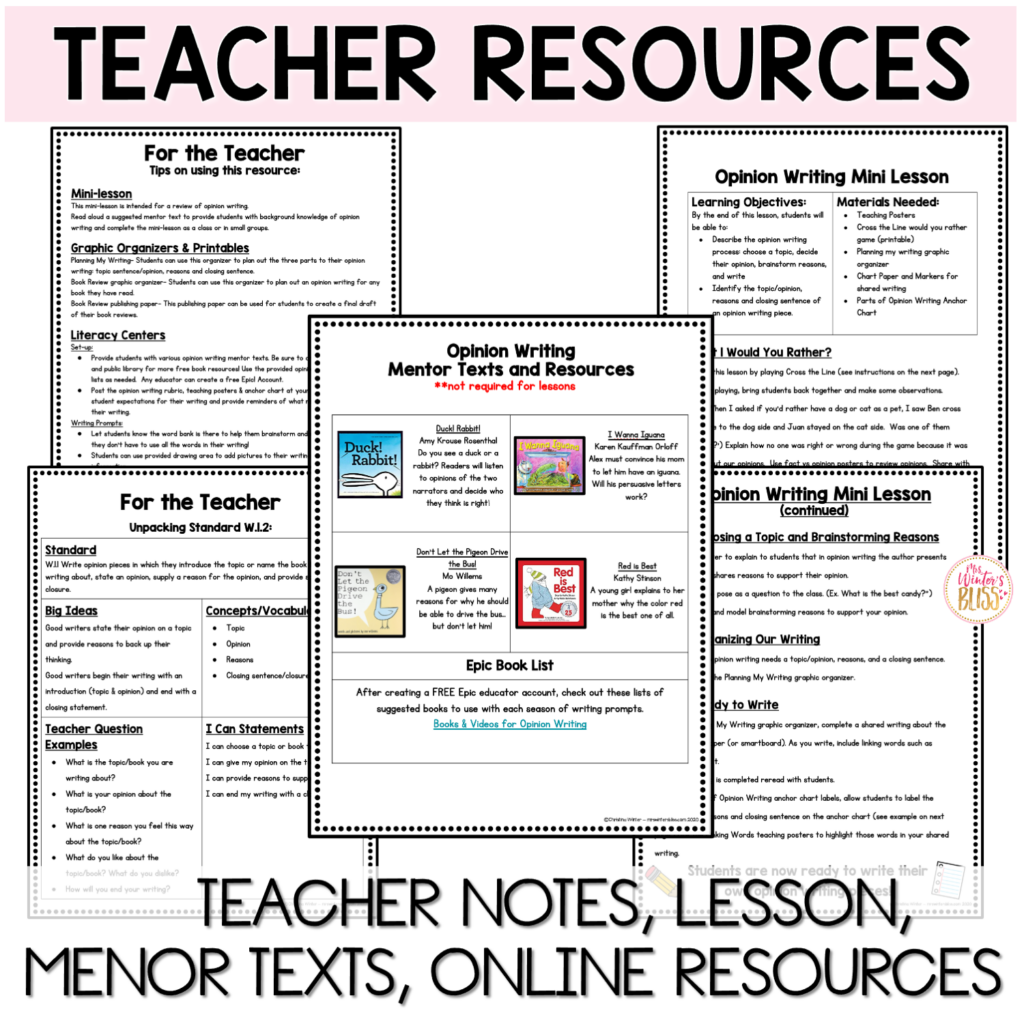
Kindergarten Opinion Writing Unit
Kindergarteners will probably need a review of fact vs. opinion so the kindergarten resource includes a printable fact vs. opinion anchor chart . You’ll also get charts with opinion writing sentence starters to help them organize their reasons and thoughts.
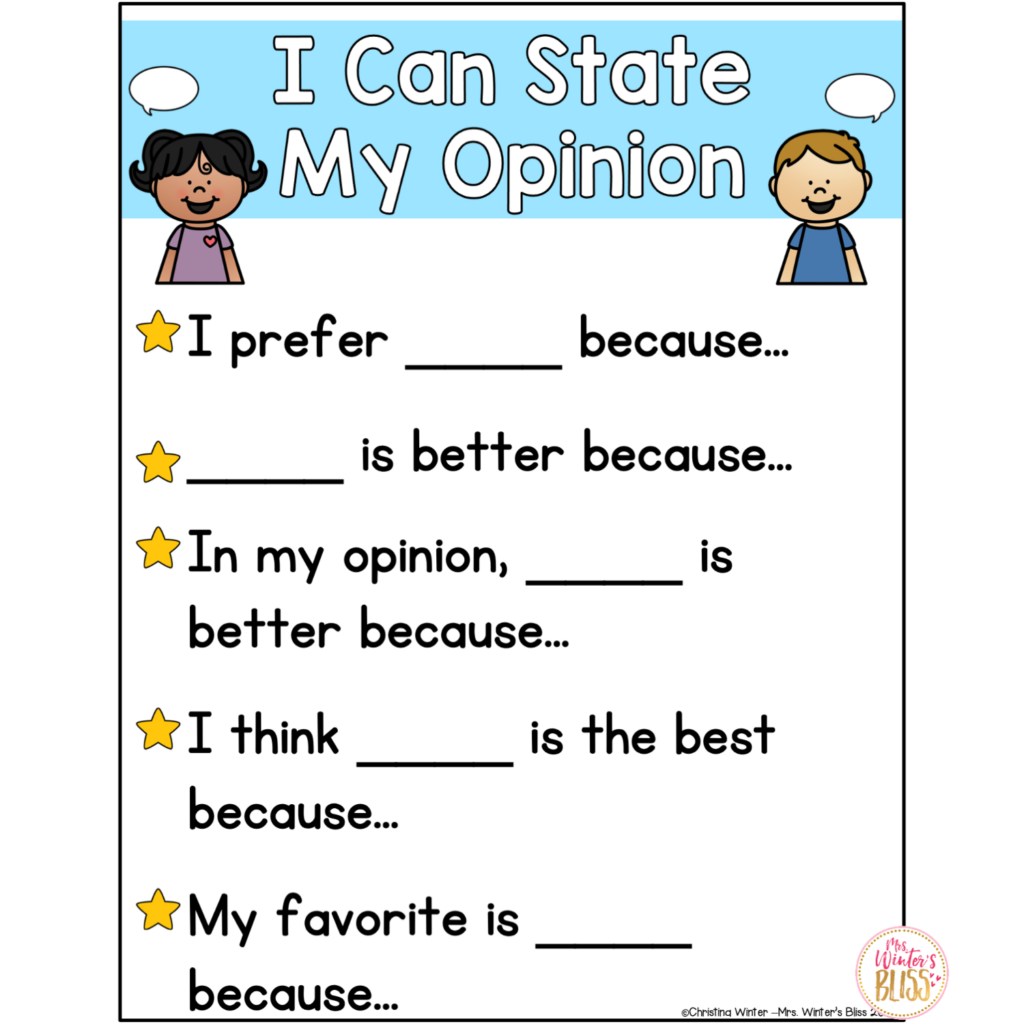
The kindergarten seasonal writing prompts come with traceable sentence stems and picture supported vocabulary word bank to assist young writers in brainstorming ideas and spelling words while writing.
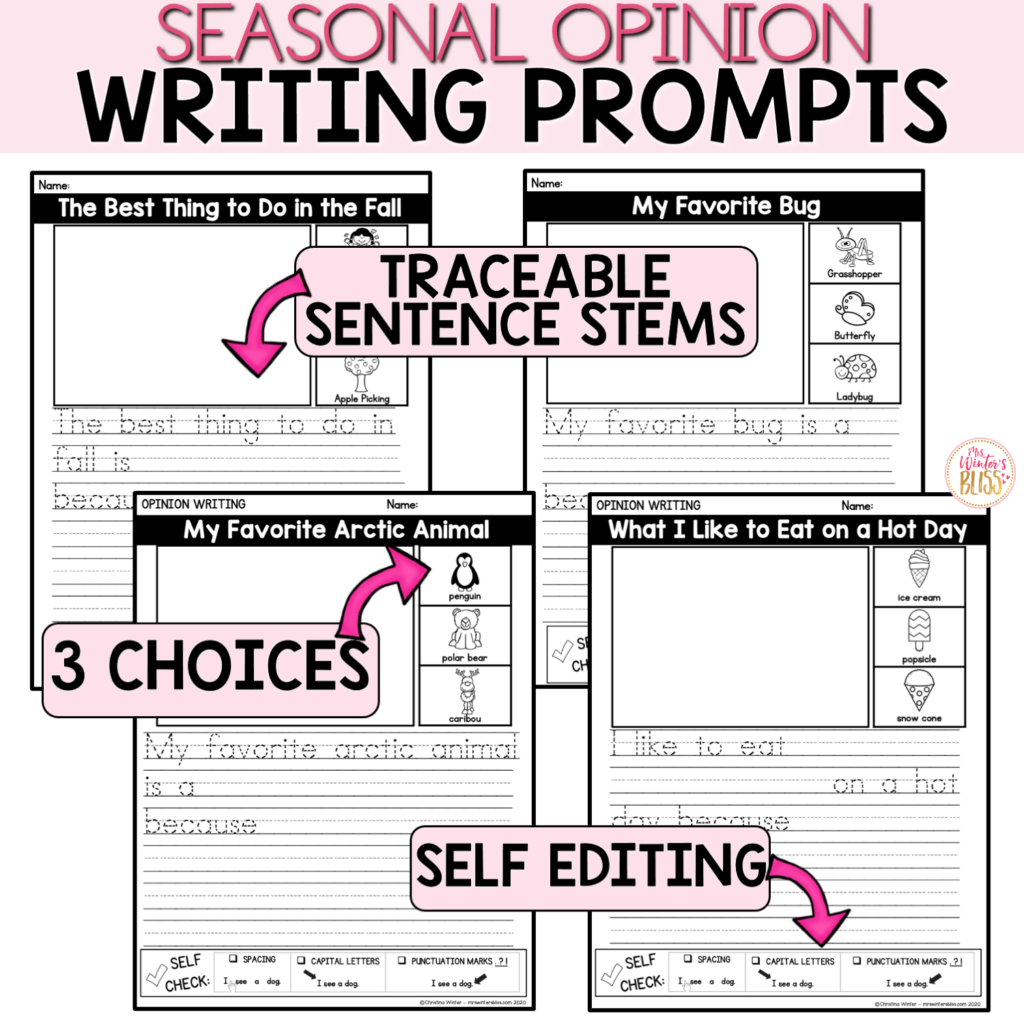
Finally, you’ll get an editing checklist that is specific to opinion writing but also appropriate for the kindergarten level.
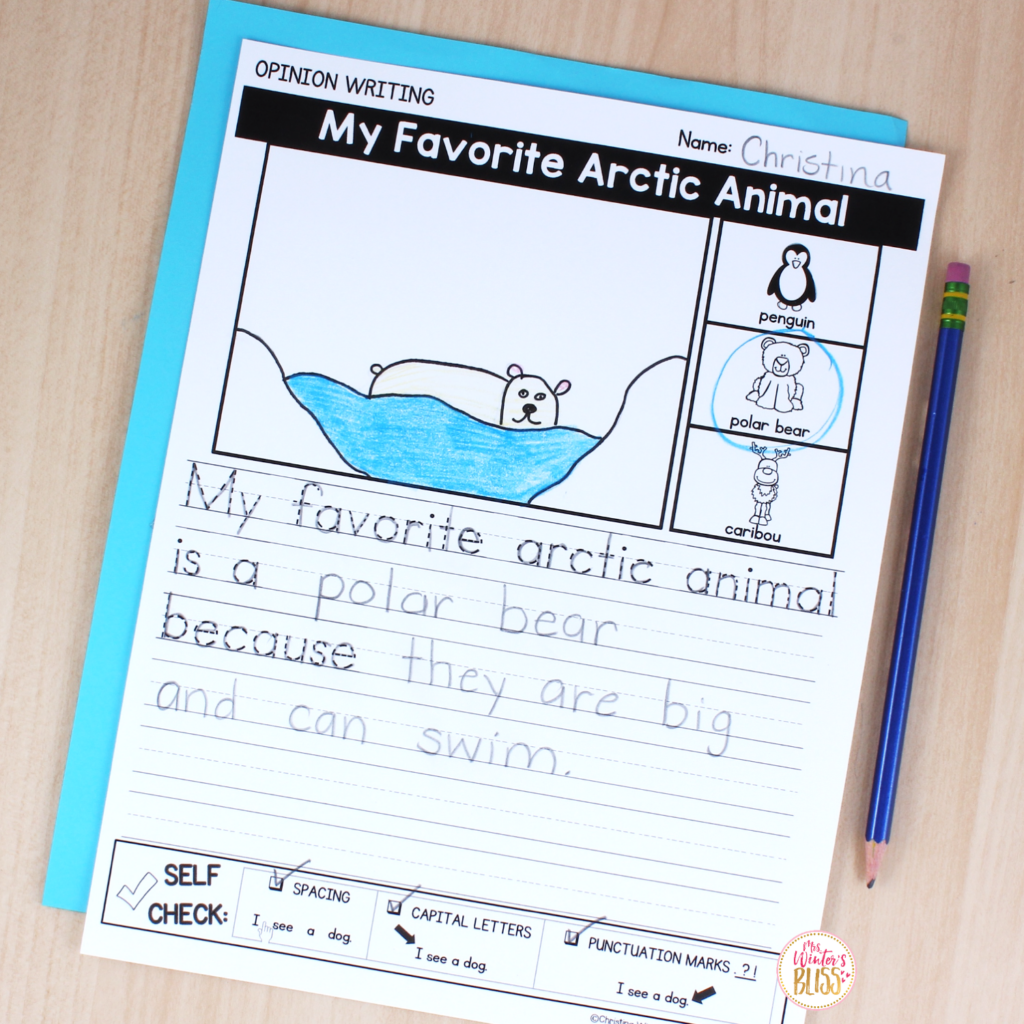
First Grade and Second Grade Opinion Writing Units
The first and second-grade resources include fact vs. opinion and linking words anchor charts that provide review and help them organize their ideas.

To help first and second-graders practice writing you’ll get 28 “Would You Rather” seasonal conversational opinion centers and 24 writing prompts. That’s more than enough to keep kids engaged in sharing their opinions all throughout the year!
The prompts are both PRINTABLE & DIGITAL. The digital version has been PRELOADED for you, with 1 click add them to your Google Drive or upload them to SeeSaw.
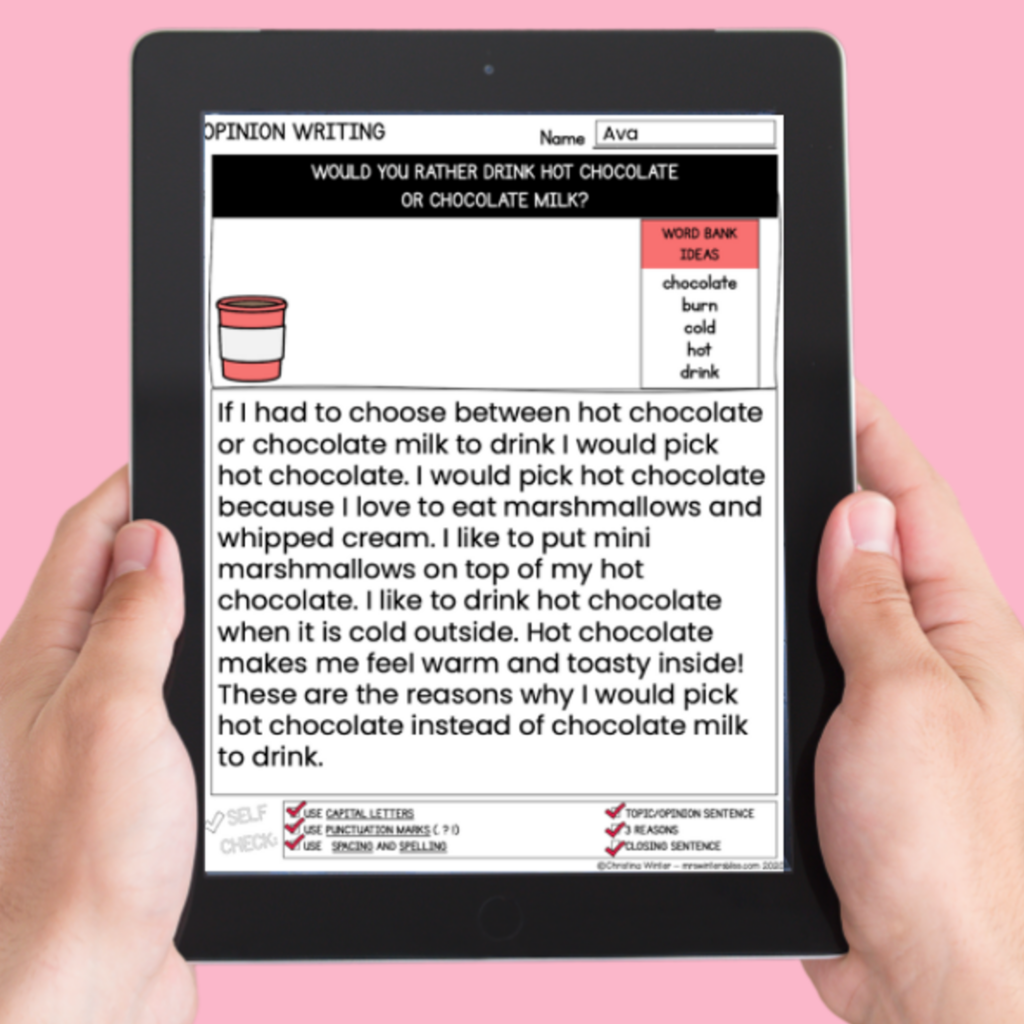
Each seasonal prompt printable paper includes a story-specific vocabulary bank to provide spelling assistance and help students get ideas for reasons to support their opinion.
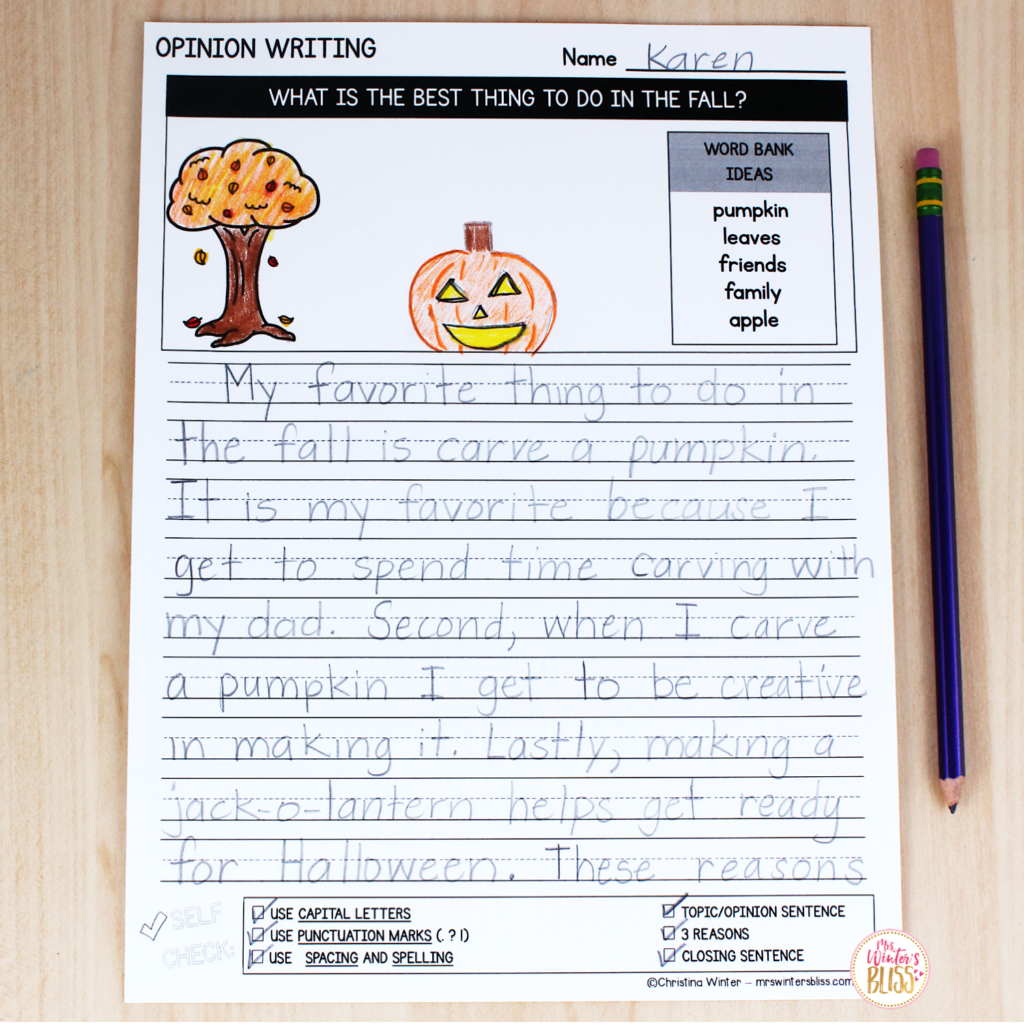
Finally, you’ll also get a self-editing checklist and rubric that have both been made specifically for opinion writing. This rubric can be used as a self-assessment tool or as a guide for peer feedback.
I love these writing units because they can be used in so many different ways. They offer opportunities for students to practice opinion writing as a whole class, in small groups, as a literacy center activity, for homework, or as a meaningful activity for when they have a substitute teacher!
FREE Opinion Writing Graphic Organizers
Are you ready to begin Opinion Writing in your classroom? To help get you started, I am happy to offer you 3 FREE Opinion Writing Graphic Organizers! You can download them here .
The ability to state one’s opinion and support it with persuasive reasons is a valuable academic and LIFE skill! I hope the information and resources I’ve shared today will help to bring stronger opinion writing instruction and more meaningful practice to your kindergarten, first and second-grade classrooms!
Be on the lookout for my next post that will focus on the final genre… Narrative Writing! I’ll share information and tips for teaching narrative writing, as well as give you details about my Narrative Writing Units for kindergarten , first and second-grade students!
-shop this post-
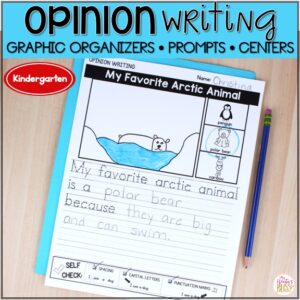
– PIN for LATER –
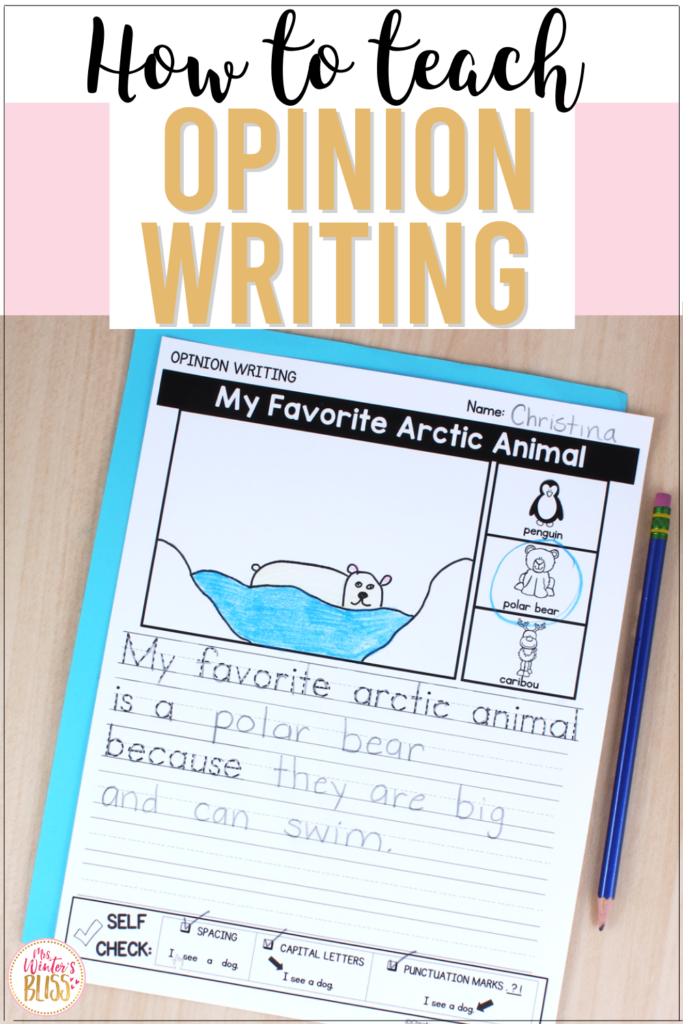
FIND WHAT YOU NEED
Teaching resources.

BLISS IN YOUR INBOX
COPYRIGHT © 2024 · TERMS AND CONDITIONS
An opinion essay

Learn how to write an opinion essay.
Do the preparation task first. Then read the text and tips and do the exercises.
Preparation
Matching_MjMxMDM=
Some people think that some types of criminals should not go to prison. Instead they should do unpaid work in the community. To what extent do you agree?
Owing to the great variety of crimes that can be punishable by prison, some people argue that not all criminals are the same and it would therefore be more appropriate to give certain criminals community service instead. I agree that in some cases, prison may not be the best solution and community service would probably have more benefits.
One justification given for prisons is to keep society safe by removing criminals from the outside world. So the first thing to consider is if someone who has broken the law is a danger to other people. In the case of violent crime, there is an argument to keep the perpetrator away from society. However, burglary or possession of drugs, for example, does not involve violence against other people so the criminal does not present a direct danger to anyone in the community. Keeping these types of criminals in prison is expensive for the taxpayer and does not appear to be an effective punishment as they often commit the same crime again when they come out of prison.
Personally, I also believe punishments should reform people so they do not reoffend. A further reason not to put these people in prison is that they may mix with more dangerous and violent criminals, potentially committing a worse crime when they are released. By keeping them in the community, helping others, they not only learn new skills, but they could also develop more empathy and care towards others. If this occurs, society can only benefit.
Critics of this more rehabilitative approach to crime believe that justice should be harsh in order to deter people from committing similar crimes and that community service could be less likely to have that effect. However, there is very little evidence to suggest that long prison sentences deter criminals.
In conclusion, putting criminals who are not a danger to society in prison is expensive and, in my opinion, ineffective, both as a deterrent and as a form of rehabilitation. Community service for non-violent crimes benefits both society and the offender. That said, it would be useful to have more data to work out whether community service or prison is more likely to stop someone reoffending. I strongly believe that decisions on how best to deal with criminals should be based on evidence of what actually works.
- Introduce your essay by restating the question in your own words.
- If the essay asks you to what extent do you agree?, make your opinion clear throughout. You can either agree, partially agree or disagree with the statement, explaining and justifying your opinion.
- Introduction
- The first reason why you agree/disagree
- The second reason why you agree/disagree
- The third reason why you agree/disagree (if you have one)
- Use phrases to organise and link your ideas, e.g. Owing to … , One justification for … , The first thing to consider is … , A further reason … , In conclusion ... .
- If you do not have solid evidence for your ideas, use modal verbs such as might , may or could (e.g. they could develop more empathy and care ) or other tentative phrases (e.g. it does not appear to be an effective punishment ).
- Conclude by restating your opinion and summarising your two or three main arguments.
Do you agree that community service is better than prison for some crimes?
Language level
Good day Sir/Madam,
I would like to ask about the expression ‘So the first thing is to…’. In academic and formal writing, should I avoid using ‘thing’ or ‘so’ or is it still fine? Thanks a lot for taking your time to read this. Hope to hear from you.
Your sincerely, Kimmie
- Log in or register to post comments
Hi kimmie,
Thanks for your question. In academic and formal writing, there is a general preference for precision over vagueness, so generally speaking it's better to avoid this usage of so and thing and use more precise and academic terms when they are available (e.g. Therefore, the first factor/issue to consider is ... ).
However, if you search academic writing, you will find writers do use thing sometimes, especially in fixed phrases (e.g. the first thing / the same thing ) or technical terms ( e.g. the Internet of Things ). Some writers might also use more general terms first before moving onto more precise terms.
(Note: The essay on the page above is in a somewhat formal style but not very formal.)
I hope that helps.
LearnEnglish team
Hi Jonathan
This is immensely valuable for me. Thank you so much for your swift response. Hope you have a nice day.
In my country it is often debated whether community services are better than prison for certain crimes. I think it's pretty obvious that it should be an option for less important faults. However, sometimes it happens that a judge decides to grant this benefit to some type of powerful criminals who cause more significant damage to society than others who do not have the same possibility, such as financial criminals or corrupt government agents. In my opinion, these types of sentences can have a bad impact on people, since they see that these behaviors are not severely punished and are somehow protected by the law. In conclusion, I agree that certain types of crimes should avoid prison, but I believe that before implementing it, the society must agree on which crimes will be able to enjoy this possibility to ensure that justice is fair for all.
please approve for testing
Hello aaron,
We check all comments before publishing them, which is why it's taken some time for your comment to be published.
Normally we delete a comment like this -- and we deleted the other one you made -- but have let this one through so you can see that it works.
We are a small team, so it can sometimes be several hours before comments are published -- just wanted to tell you for the future.
We look forward to hearing more from you!
All the best, Kirk LearnEnglish team
The subject of how criminals should be punished is complicated, there are a lot of different opinions defending their points of view. There are two main ideas the first is arresting all the offenders, and the second idea is separating those not dangerous to society, and sending them to work in the community. In my opinion, I agree with the second idea, because there are many expenses with the prisons and the prisoners, so if lessen the population in this environment the conditions and the quality could be better than if there were overpopulation, avoiding justice being done right. Furthermore, these people aren't violent and dangerous to others, so with bad company in the prison, they might become bad people too. In this case, it's an awful idea to mix a different kind of person. Therefore, it's an excellent suggestion to oblige these people to do work in society, but with supervision in the right way and strictly.
On account of the differences between several types of crimes, not all criminals should be sent to prison. It is suggested that giving certain offenders community service would be more appropriate than just jailing them.
Honestly, I completely agree that the right way to protect people from harm is to imprison criminals who conduct violent crimes that endanger human physical health. Nevertheless, this penalty may be ineffective with offenders who have administrative guilts or non-violent offenses. Since they often commit the same crime after getting out of prison, this is just a temporary punishment to ensure the security of citizens for a certain period. The nature of the problem is these crimes originate from greed and bad habits which lead to their deviant behaviors but have not yet resulted in such severe consequences that affect human life.
From my perspective, the government would rather reform these types of offenders than deter them as a kind of punishment. It is better to have an alternative that perceptively impacts these people’s awareness which is to make them do community service. Jailing these criminals just increases their hatred and develops antisocial personality. By keeping and controlling them in a community, besides learning new skills, they amend their bad manner as well as develop more empathy and care towards others.
Given these points, the application of punishment should be based on the nature of each specific crime. Prisons should only be used for perpetrators committing directly dangerous crimes to people's lives. Making non-violent criminals do community service is more of a practical way to optimize tax wasted for prisons as well as give them a chance to fix their wrong behaviors.
There are several types of crimes and for each of them, a different sentence is dictated. A paramount question to be considered is whether community servers are more accurate than prisons for some crimes.
To begin with, community servers would help and support criminals through specialized psychologists. Not only would community servers help and support them, but also it would give them jobs to help them give the society back a contribution in return.
In addition, prisons only contribute to worsening the situation owing to the fact that criminals will commit crimes again. The key to excellent behavior is learning. If they learn suitable habits, they will adapt to society and help it.
Furthermore, it is necessary to have empathy with criminals and not judge them because their hate increases when they are condemned in prison. A further reason for this is that hate feeds hate. Nevertheless, some criminals must be in jail due to their danger on the streets. It is difficult to know that a person who kills someone else, is going to change even if he/she receives help from psychologists.
In contrast, most of society believes that all criminals should be in prison. However, prisons must be all comfortable like a hotel in order to bring for the prisoners a place to recover themselves. The reason why they must live in appropriate conditions is due to his mental health. For instance, in Norway, prisons are like hotels because the government considers that criminals need a second chance to live in a community
To conclude, it would be suitable for all criminals to live in accurate prisons in order to recover themselves. Despite the cost that kind of prisons are supposed to take, they are worth paying for them. In my opinion, safety is priceless and is more important than the cost.
There are many things to consider in punishing criminals or law offender, Technically Speaking, Prison sentence varies entirely depending on a Country's legal system.
I partially agree in reinforcing community service to those non violent criminals, whereas harsh punishment for violent criminals who committed felonious crime. This perspective is reflected on my understandings in a community where social injustice is prevalent. In my country misdemeanor crime and felony crime offender are detained in the same prison cell, they only differ in the duration of prison sentence. This is where the serious societal issues of crime rate initially rooted, non violent offenders are mixed up with serious offenders, doing and smuggling drugs all a while in prison.
Further reasons to justify harsh punishment for felonious crime is it can act as deterent for potential criminals, while community service may reinforce less serious offender to reflect on their own actions and give back to the community. Moreover it may help them develop empathy towards others.
In my conclusions punishment should vary on the severity of the crime of the perpetrator, Criminals should be legally convicted and fairness in prosecution of Criminals must be reinforce.
Online courses

Group and one-to-one classes with expert teachers.

Learn English in your own time, at your own pace.

One-to-one sessions focused on a personal plan.

Get the score you need with private and group classes.

- Character Traits
- Compare and Contrast
- Read Alouds
- Point of View
- Reading Response Ideas
- Summarizing
- Text Features
- Text Structures
- Find the Fib
- Reusable Ideas
- Disclosure Policy
- Lifetime Access
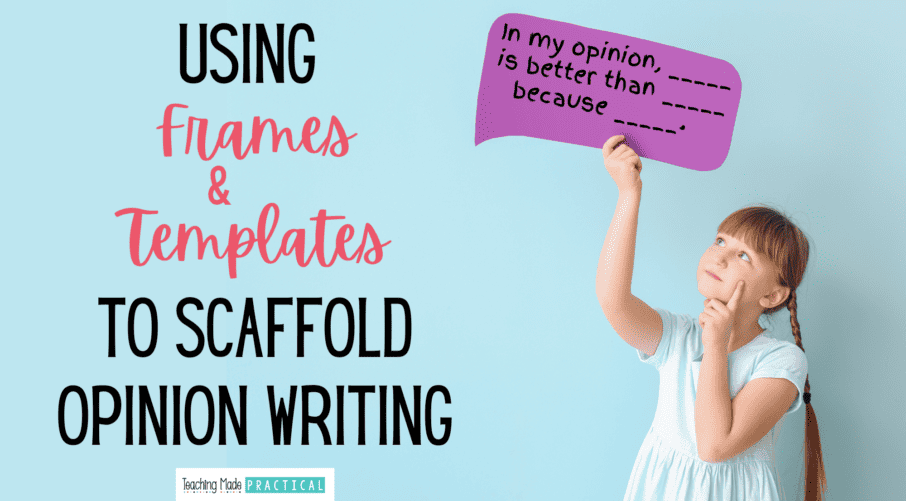
Scaffolding an Opinion Writing Essay With Frames and Templates
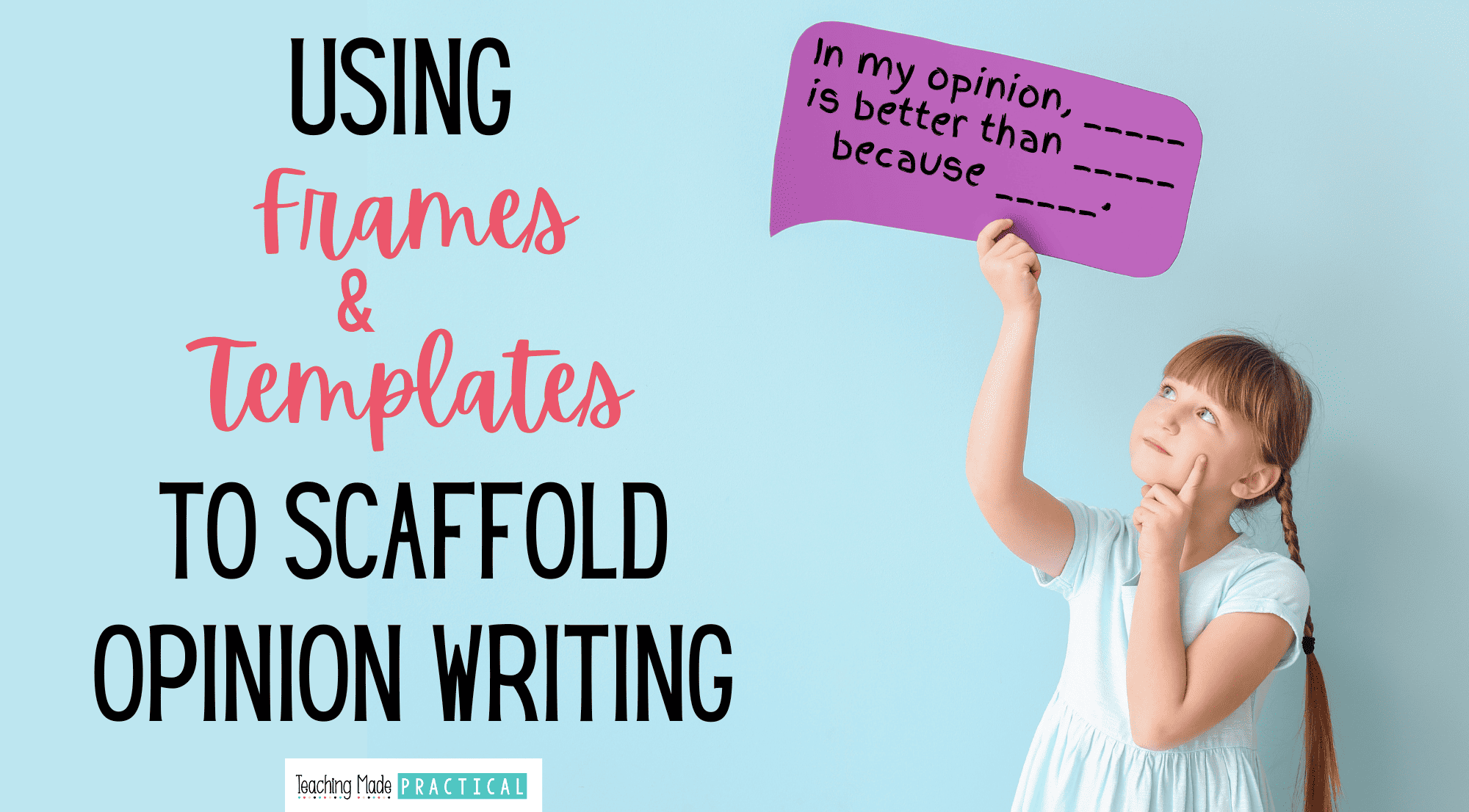
Teaching opinion writing to your 3rd, 4th, or 5th grade students soon? Use the sentence starters and paragraph frames below in your lessons to help students structure their writing, use transitional words, stay on topic, and support their opinions.
Templates like the examples below are a great way to introduce opinion writing. The hope is that eventually, students will go on to write without a provided outline and add a little of their own personality to their writing, but starting off with a clear structure helps students learn to become better writers.
Start Small - With Opinion Writing Sentence Starters or Frames
3rd, 4th, and 5th grade students love giving their opinions, so help them structure their opinions with sentence starters and frames. This is a great way to introduce opinion writing and doesn't frustrate students.
Providing structure is especially beneficial for your ELL and low language students, but ALL students can improve their writing with this scaffolding.
Some example sentence starters are below. Depending on the topic being discussed and the opinion being shared, not all sentence frames will work in all situations. Adapt them for your particular scenario!
Example Sentence Starters
- In my opinion, _____ is better than _____ because _____.
- The best thing about _____ is _____.
- I am strongly against _____ because _____.
- Although some people believe _____, I believe _____.
- Ever since _____, I have believed _____.
Using a Paragraph Template or Frame
Example paragraph frames.
In my opinion, __________ is better than __________ because __________. For example, _______________. Furthermore, _______________. Clearly, _______________ is the worse option.
I prefer __________ because __________. For instance, _______________. Also, _______________. Finally, _______________.
Opinion Writing Essay Template / Structure / Outline
Going from writing paragraphs to writing an entire essay can be overwhelming for upper elementary students - and middle school students as well!
Modeling how to write an opinion essay is an essential first step. (My Scaffolded Opinion Writing Resource includes a teacher model to make this easy for you.)
After modeling an opinion essay, provide students with an opinion writing template/outline to help them structure their own writing. This will help students stay on topic, use transitional words, and provide support for their opinions. And, most importantly, it will keep students from feeling overwhelmed and frustrated.

If you know your students would benefit from this type of scaffolding but don’t have the time to create it yourself, check out my Scaffolded Opinion Writing Resource.
It walks students through the writing process with support each step of the way. This resource also provides a model essay so that you can model expectations for your students. Plus, it can be used over and over again with different topics.
If you found these opinion writing tips to be useful, then you will probably like these tips for teaching students how to write a compare and contrast essay.
Want a Compare and Contrast Freebie?
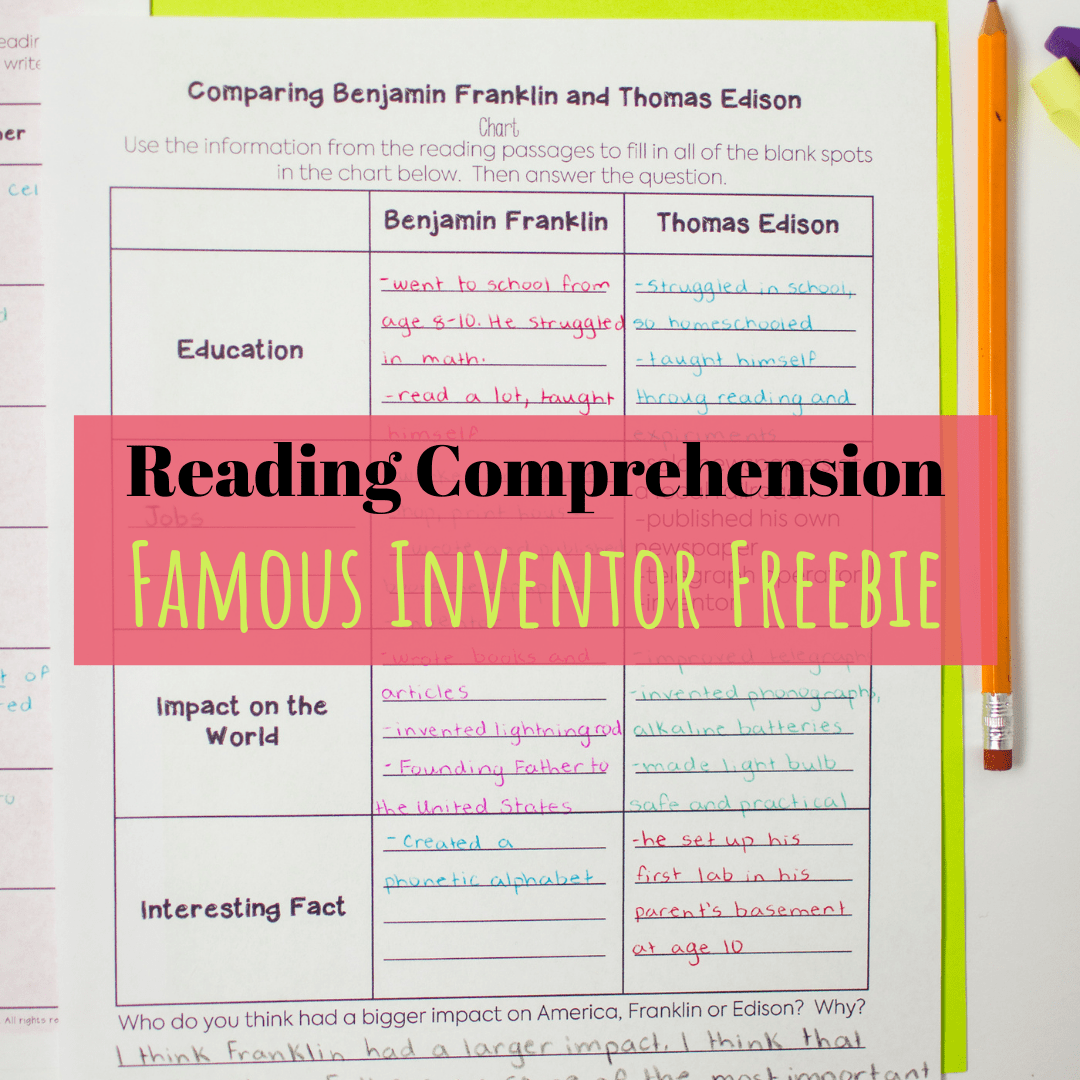
Download these reading passages with a compare and contrast activity for free and use it to today!
Home » Anchor Charts » What Is An Opinion Writing Anchor Chart And Where To Find One Online

What Is An Opinion Writing Anchor Chart And Where To Find One Online
Learning how to write academically can pose a challenge. Students need to get familiar with several types of writing, and it can be difficult to keep up with different formats and approaches for each writing style. Younger students especially struggle as they’re new to writing in general and need help with the basic concepts, such as paragraphs and transition words.
An anchor chart is there to help them visualize the information you present, and they can also use it as a reference point in the future. We’ll show you what an opinion writing anchor chart should consist of and where you can download high-quality, ready-to-use anchor charts for your class.
What Is an Opinion Anchor Chart
Unlike informational writing, which presents facts as they are, opinion writing is there to show the author’s point of view on a specific topic and to persuade the reader to agree.
An opinion anchor chart is a teaching tool that helps students get a visual representation of the writing format, as well as some of the writing concepts . The chart also serves as a reminder they can turn to when writing their essay.
A writing anchor chart can focus on different elements of writing, but you should always start with the ones that focus on the structure, such as:
- Introduction anchor chart
- Paragraph anchor chart
- Conclusion anchor chart
- Body paragraph anchor chart
Elements of a Good Opinion Writing Anchor Chart
How exactly would you create an opinion writing anchor chart? Well, again, much like opinion itself, that varies. How you do it depends on your students’ age and cognitive level. Even so, however, the basic anchor principles are the same. How far you go with them can be adapted to suit the grade level.
Differentiate between ‘fact’ and ‘opinion’
Fact and opinion are both important in writing a good opinion piece because they serve different purposes. Facts provide the foundation or support for an opinion. In contrast, opinions are the main idea or position the student tries to express.
It’s important to differentiate between the two so that students understand how to use them effectively in their writing. And, believe it or not, they often struggle to understand the difference.
For example, they may think a statement like “John thinks ice cream is the best food on earth” as an opinion, informing the reader of John’s attitude towards ice cream. However, the fact remains that John thinks ice cream is the best food on earth.
An opinion would be assuming that everyone should feel the same way. For example, “Ice cream is by far the best food on earth”.
An opinion piece without any facts to back it up is likely to be less convincing and less effective. Finding a middle ground between the two is important to write an effective opinion piece.
Show the differences between an opinion piece and a commentary
Students often confuse an opinion piece with a commentary. An opinion piece is a personal response to an issue – like a current event, a school or home rule, or even a new menu in the cafeteria. A commentary, on the other hand, is an unbiased analysis of an issue or topic. But, unlike an opinion piece, a commentary doesn’t offer the writer’s personal take on a subject.
You can illustrate this with a chart or table that shows the differences between opinion and commentary. For example, in the “Opinion” column, you might write, “Opinion is personal,” ; whereas in the “Commentary” column, you could write, “With commentary, it’s nothing personal” .
Show them how to organize their ideas with an essay outline
Create a simple visual representation of the framework – or essay outline. An opinion piece can’t be written off the bat. Students will need to construct an opinion piece. A standard essay outline lists the main points covered in the piece. So, first, pick a topic.
Alternatively, each student can pick their own topic, and you can all work on your anchor charts together. Next, create a mind map of the beginning, middle, and end of the “story” or opinion that needs to be put across: i.e., opening statement, argument, and conclusion.
Demonstrate persuasive writing
An opinion piece is written to persuade the reader to share the writer’s point of view on a topic. To write an opinion piece, you must develop the three key components from the previous point above a strong opening statement, an argument (or supporting paragraphs), and a concluding paragraph.
The first paragraph should grab readers’ attention and offer a detailed topic summary . The second paragraph should feature one or more supporting examples to help prove your point. The final section should conclude the topic and summarize the main points of your opinion piece.
Writing Hooks Anchor Chart From Sassy Savvy Simple Teaching
Opinion writing hooks anchor charts are the first charts you should introduce to your students when it comes to actual writing. Use charts to show them what a hook is and how they can use it to pull the reader in.
Since writing a hook can be difficult for students, try to provide them with colorful examples and leave empty spaces for them to fill out. This will help them get a visual aid of hooks and start their creative process.
You can have an anchor chart that focuses on one or all of the most common hook types:
- Interesting fact
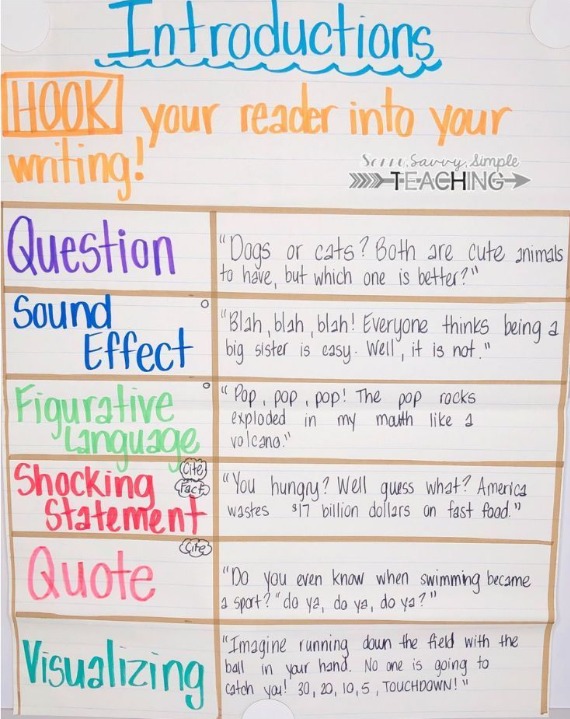
Opinion Transition Words Anchor Chart From Weebly
Show the students how they can link sentences and paragraphs together with transition words. This is a powerful tool that many students (especially younger ones) neglect, and they can get used to using it by having a chart by their side. This chart can help them come up with the appropriate transition word. As time goes by, using transition words will become more natural, and they won’t have to refer to the anchor chart every time.
You can use different designs here, depending on how you want them to use transition words. For example, you can use a stoplight design and give examples for three types of transition words:
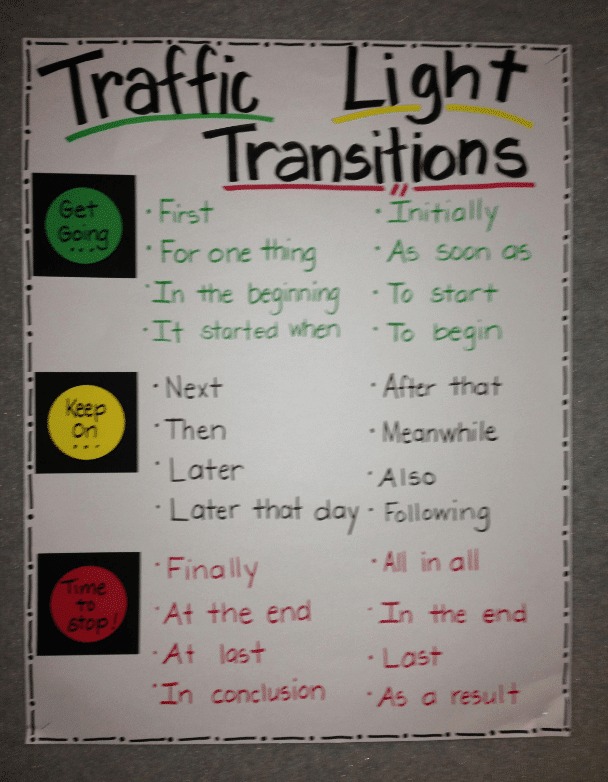
Opinion Reasons Anchor Charts—OREO From Our Global Classroom
Opinion Reasons anchor charts are great as they teach students about the structure of a good opinion writing piece. It shows how they’re supposed to present their thoughts and how to reinforce them with logic. Having a memorable acronym is only a bonus.
Use this chart to introduce the OREO formula and show students how to present their ideas. The formula is as follows:
- Opinion —Introduce your opinion about a given topic
- Reason —Provide information or logical explanations that support your opinion
- Examples —Give details and real-life scenarios that support your opinion
- Opinion —State your opinion again to affirm your point of view
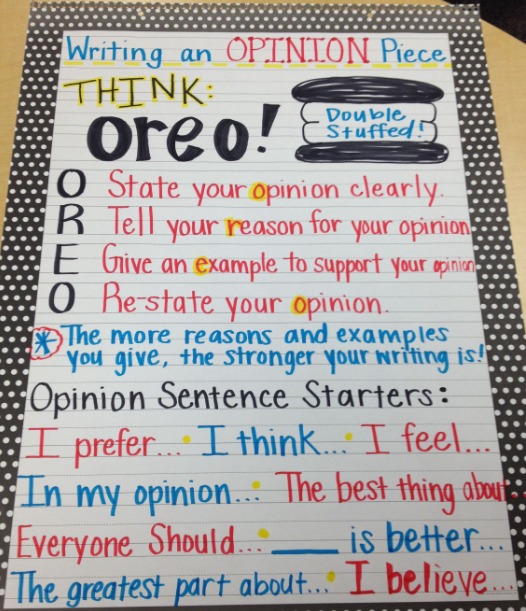
Download High-Quality Opinion Writing Anchor Charts From Teach Simple
While writing anchor charts can be straightforward, and you can even get your students to make them, they still need to be carefully thought out. How do you make sure you use all the necessary information and the easy-to-remember definitions? Planning an anchor chart can be difficult, and it can take you hours, especially if you’re new to it.
If you don’t have the time (or the will) to come up with your own for every class you plan, you can sign up for Teach Simple and find thousands of lesson plans , anchor charts, and other materials related to ELA and writing in particular.
Every product listed on Teach Simple is made by a teacher exclusively, and other teachers review each material to ensure it meets various standards and quality requirements. This way, you can rest assured you’ll enrich your classes with high-quality anchor charts made by people who know what it takes to teach students different types of writing.
Different ways to use anchor charts to teach opinion writing
Let’s look at how anchor charts can be used differently to highlight opinion writing.
Scaffolding From Lucky Little Learners
Students who are not proficient in each element of scaffolding writing can become overwhelmed quickly, so instruction in these elements is crucial. However, breaking them down into bite-sized portions will make them much more manageable.
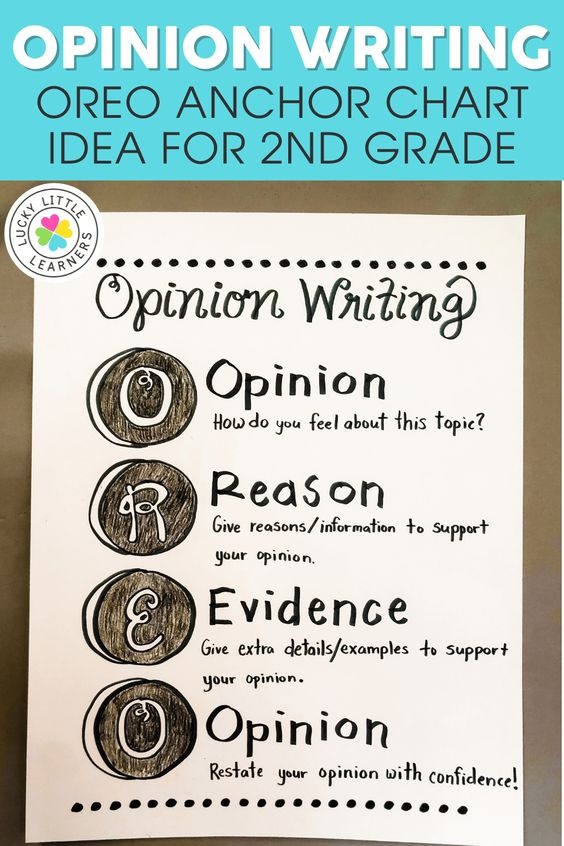
Fact Vs. Opinion sorting From Lucky Little Learners
Sorting facts and opinions is something that should be done in groups. What better way to get your students to express their opinions? And you can build the anchor chart together, making it far more relevant to the students. You could use many techniques to practice this skill with your team. For example, ask your students to jot down one thing they know about broccoli on a post-it note and stick it to the board. The students will typically write that it’s green, tasty, gross, healthy, and a vegetable. Once the notes are placed on the board, discuss whether a claim is a fact or an opinion and categorize it.
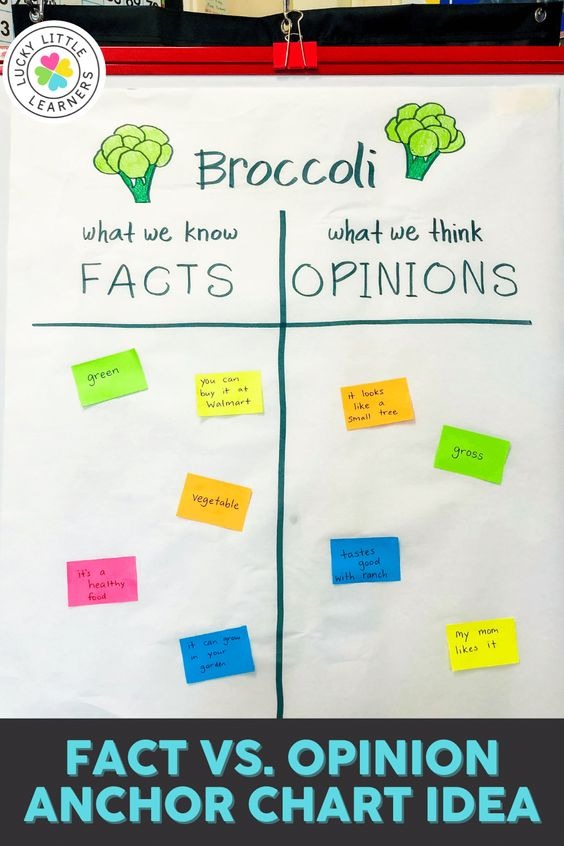
Display examples
It is essential to show students what various levels of mastery look like. Showing your students examples of completed writing can help them visualize expectations and encourage them to keep working and growing.
Model good opinion writing from Mrs. Winter’s Bliss
To illustrate how you would use a graphic organizer to plan your writing, model it for your students. At the beginning of your writing, introduce your perspective with a topic sentence. Next, list your supporting arguments. Finish with a final sentence that reiterates your viewpoint. As a group, identify the topic sentence, the supporting reasons, and the conclusion in your shared writing.
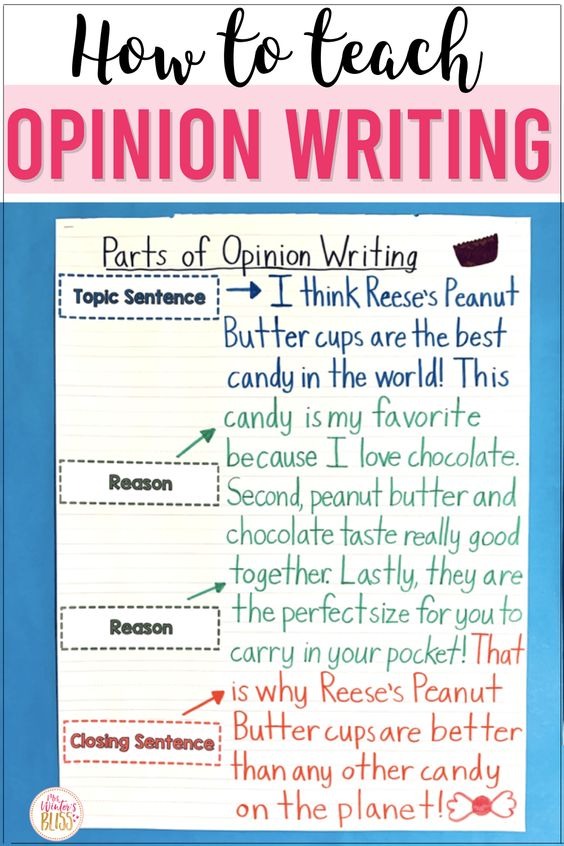
Opinion Essay Structure From Wild About Fifth
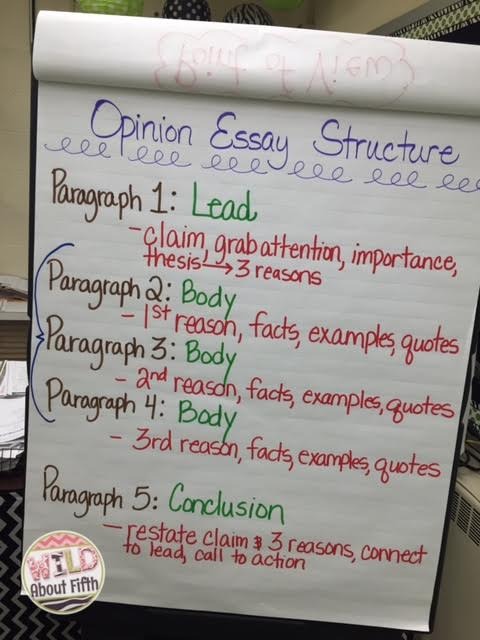
Opinion writing resources from Teach Simple
Looking for an opinion writing chart that covers all the bases? Here is everything you need. All these charts and resources support the elements you need to get started to ensure your students understand how to express their opinion in writing.
Opinion writing anchor chart By First in Line
These charts give students the O.R.E.O. acronym to remember and can be placed on a display board or in their notebooks.
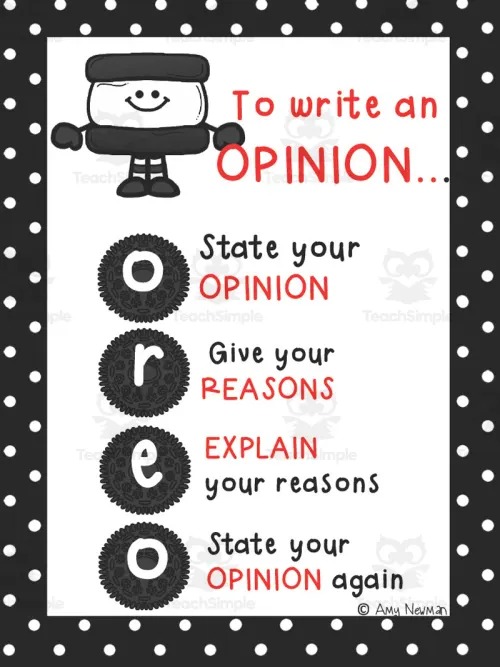
Digital graphic organizers By Teach Me This
This resource is jam-packed with digital opinion writing templates that will give your students multiple opportunities to practice this comprehension strategy.

“What do you think?” opinion writing activity By Have Fun Teaching
This graphic organizer is perfect for younger students and guides them every step of the way.
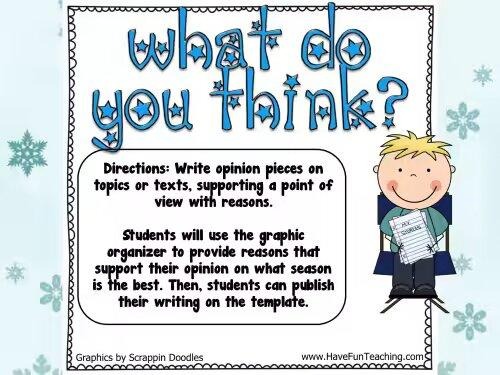
“Would you rather…?” By Aunt Minty’s Education Place
This resource is compiled with 20 high-interest opinion/persuasive writing activities designed for students in Grades K-3.
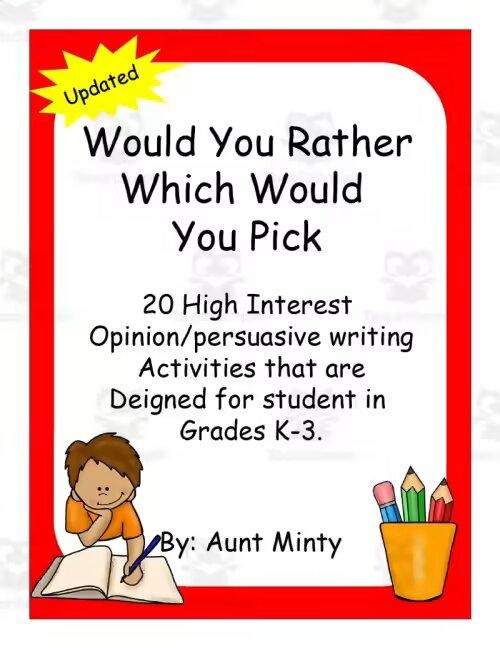
Opinion writing unit – analyze two accounts of the same topic
This resource lets students practice analyzing multiple versions of the same issue and integrating their learning into a complete opinion response.
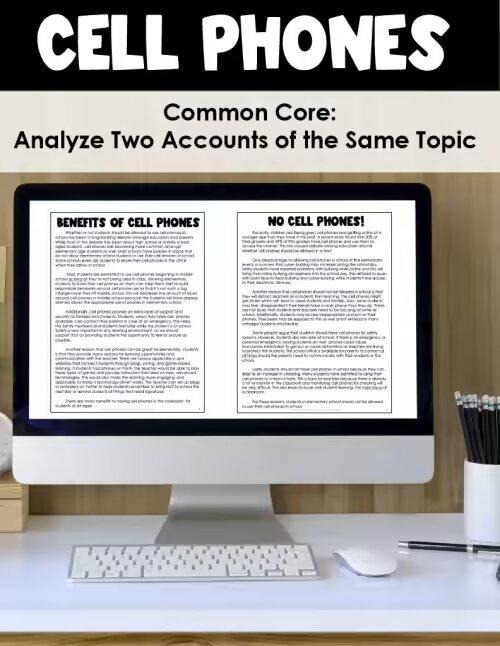
Opinion writing unit: paid for chores By Life Beyond the Gradebook
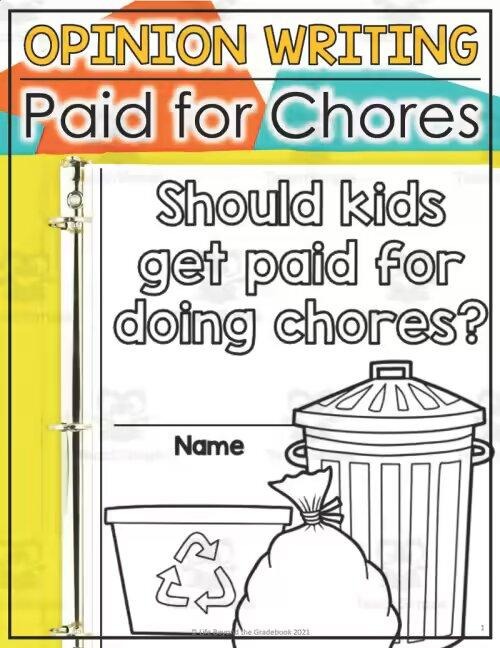
Two texts are included in this resource, one in support of the topic, and one against the topic. The students should use these texts to find evidence that supports their own opinion and use it in their essays.
Opinion writing Anchor Charts from Teachers
Opinion transitions from art of it.
Sentence starters and transition examples can ease students in and take some of the pressure off.
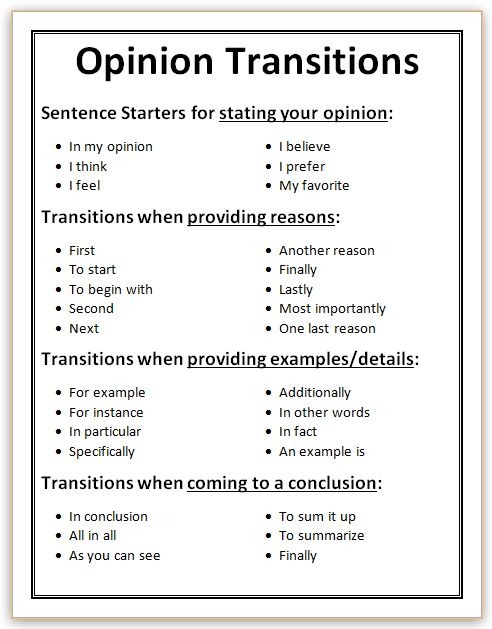
Opinion writing planner From Art Of It
This prewriting graphic organizer will guide students through their planning process.
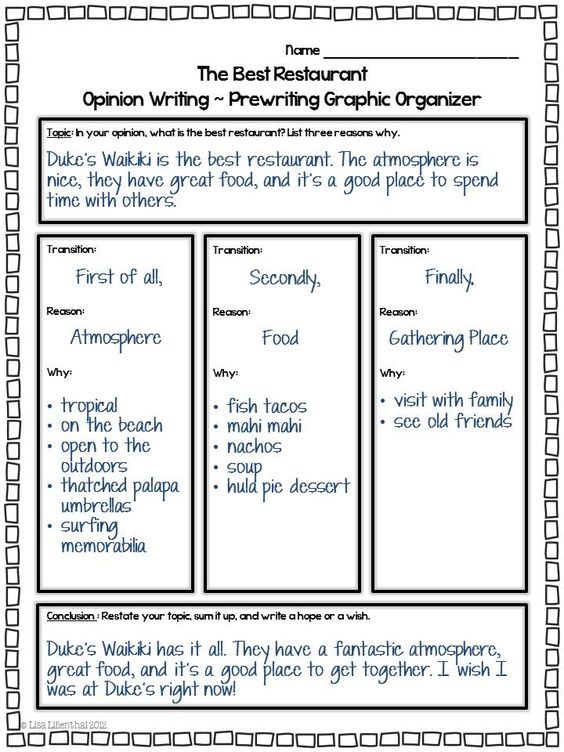
Opinion writing checklist From Worksheetplace
This checklist is great for helping students check their work to ensure they have covered everything.
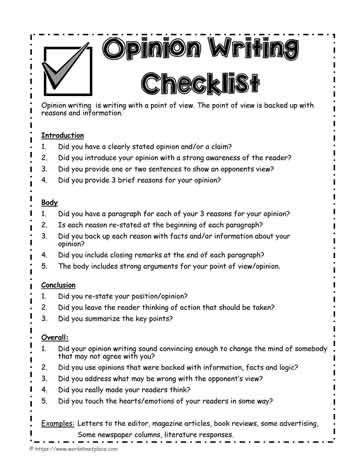
Having a wide variety of opinion anchor charts available can help break down a topic into smaller chunks and make it easier to understand. In addition, using visual aids like anchor charts helps make the lessons more memorable and engaging. Finally, when students need a confidence boost, they are usually grateful to have something to refer so they can move forward independently.
Check out our top pick for anchor charts for writing :
- Opinion Writing Anchor Chart
- Writing With a Purpose Anchor Chart
- Anchor Charts for Writing
- Appeal to Senses Anchor Chart
- Poetry Writing | Anchor Charts & Visuals
- Anchor Charts Professional Development
- Fact and Opinion Anchor Chart
- Idioms Anchor Chart
- Homophones Anchor Chart
- Writing a Beginning, Middle, and End
- Verbs Anchor Chart
- Nonfiction vs. Fiction Comparison Anchor Chart
- Teaching Plot Anchor Chart
- Author’s Claims Anchor Chart
Share Article:
Download unlimited teaching resources, join free today, teach simple.
The team behind Teach Simple is a small but dedicated group who are passionate about education and making a positive impact on the lives of teachers and students.
We have a lot of interesting articles and educational resources from a wide variety of authors and teaching professionals.
What Is A Theme Anchor Chart And Where To Get Them Online
Informational writing anchor charts—what types there are.
Last Updated on August 30, 2023 by Teach Simple
49 Opinion Writing Prompts for Students
- Lesson Plans
- Grading Students for Assessment
- Becoming A Teacher
- Assessments & Tests
- Elementary Education
- Special Education
- Homeschooling
:max_bytes(150000):strip_icc():format(webp)/squareheadshot-5b6da9aec9e77c0050a6e8a5.jpg)
One of the most common essay types is the opinion, or persuasive, essay. In an opinion essay , the writer states a point of view, then provides facts and reasoned arguments to support that viewpoint. The goal of the essay is to convince the reader to share the writer’s opinion.
Students aren't always aware of how many strong opinions they already hold. Use the following opinion writing prompts to inspire them to start thinking and writing persuasively.
Prompts About School and Sports
School- and sports-related topics often elicit strong opinions in students. Use these writing prompts to kick off the brainstorming process.
- Ch-ch-ch-changes . What is one thing about your school that needs to change? Is bullying an issue? Do students need longer breaks or a dress code? Choose one vital issue that needs to change and convince school leaders to make it happen.
- Special guest. Your school is trying to decide on a famous person to give a speech or presentation to students. Who do you think they should choose? Write an essay to convince your principal.
- Oxford or bust. Is the Oxford comma essential or obsolete?
- Scribble scrabble. Do students still need to learn cursive handwriting?
- Co-ed conflict. Would students perform better if more schools were single-gender rather than co-ed? Why or why not?
- Participation awards. Should there be winners and losers in sports, or is participation the ultimate goal?
- Homework overload. Write an essay to convince your teacher to assign less homework.
- Sports. Which sport (or team) is the best? What makes it better than the others?
- No slacking . Write an essay persuading a fellow student to do their homework.
- Class trip. This year, students get to vote on where to go for a class trip. Write an essay convincing your fellow students to vote for the place you’d like to go.
- Superlatives. Which would you rather be: a top student, a talented athlete, or an accomplished artist?
- Virtual athletes . Video games competitions are often aired on TV and treated like sports competitions. Should video games be considered sports?
- Class debate. Should classes that students may not use or that don’t interest them (such as physical education or foreign language) be required?
Prompts About Relationships
Friendships, dating, and other relationships can be both rewarding and exasperating. These writing prompts about relationships will help students explore their feelings about both the positive and the negative moments.
- Snitch. Your best friend tells you about his plan to cheat on a test. Should you tell an adult? Why or why not?
- Give it a chance. Your best friend is convinced that she would hate your favorite book, even though she's never read it. Convince her to read it.
- Friendships vs. relationships. Are friendships or romantic relationships more important in life? Why?
- Driving age. What age do kids start driving in your state? Is that age too old, too young, or just right? Why?
- Truth or consequences. Your best friend asks your opinion about something, but you know that a truthful answer will hurt her feelings. What do you do?
- Who chooses? Your best friend is visiting, and you want to watch TV together, but his favorite show is at the same time as your favorite show. Convince him that your show is a better choice.
- Fun times. What is the most fun thing you and your best friend have ever experienced together? Why does it deserve the top spot?
- Dating. Are long-term dating relationships good or bad for teens?
- New friends. You want to spend time with a new student at school, but your best friend is jealous. Convince your friend of the importance of including the newcomer.
- Be mine. Is Valentine’s Day worthwhile or just a scheme for the greeting card and chocolate industry to make more money?
- Debbie Downer. Should you cut ties with friends or relatives who are always negative?
- He loves me not. Is it really better to have loved and lost than never to have loved at all?
- Elders. Should you respect your elders merely because they are older, or is respect something that must be earned?
Prompts About Family, Pets, and Leisure Time
The following writing prompts related to family, furry friends, and free time will help students reflect on preferences, ethics, and integrity.
- Self-reflection. This time, you're the one who needs convincing! Write an essay to persuade yourself to start a healthy habit (or kick a bad habit).
- Paper wars. Should toilet paper hang with the loose end resting on the top of the roll or hanging from the bottom?
- Movie vs. book. Choose a book that has been made into a movie. Which version is better, and why?
- Weekend wanderings . Do you prefer to stay home on the weekends or get out and do things around town? Write an essay to convince your parents to let you do what you prefer this weekend.
- Sweepstakes. A travel agency is hosting an essay contest to give away an all-expenses-paid trip to the one place in the world you’d most love to visit. Craft a winning essay that convinces them they need to choose you.
- Zoo debate. Is it ethical to keep animals in zoos? Why or why not?
- Presence of pets. Should there be limits on the types of places pets can go (e.g. airplanes or restaurants)? Why or why not?
- Inspiring stories. What is the most inspiring book you’ve ever read? Why is it so inspiring?
- Dollar discovery. You find a $20 bill in the parking lot of a crowded store. Is it okay to keep it, or should you turn it in to customer service?
- Vacation day. What is the very best way to spend an unexpected day off from school and why is it the best?
- Digital or print? Is it better to read books in print or digitally? Why?
Prompts About Society and Technology
The people and technology around us have a significant impact on our lives. These writing prompts encourage students to consider the effect that society and technological advances have on our day-to-day lives.
- Reverse technology. Pick one technological advancement that you think the world would be better off without. Explain your reasoning and persuade the reader.
- Out of this world . Do aliens exist? Why or why not?
- Social media. Is social media good or bad for society? Why?
- Emoji. Has the use of emoji stunted our ability to express ourselves in writing, or does it help us identify our emotions more precisely?
- Auto safety. Have advancements like self-driving cars, blind spot indicators, and lane departure warning systems made driving safer, or have they just made drivers less attentive?
- Exploration Mars. Write a letter to Elon Musk convincing him that you should be part of a colony to Mars.
- Fundraisers. Is it okay for kids to stand outside stores and ask shoppers for money for their sports teams, clubs, or band? Why or why not?
- Inventions. What is the greatest invention ever made? Why is it the best?
- Important cause. In your opinion, what global problem or issue deserves more attention than it currently receives? Why should more time and money be invested in this cause?
- Minimalism. Does living a minimalist lifestyle make for a happier life? Why or why not?
- Gaming gains. Are video games generally a positive or a negative influence? Why?
- Rose-colored glasses. Is the current decade the best era in history? Why or why not?
- Paper or plastic. Should plastic bags be outlawed?
- Writing Prompts for Elementary School Students
- January Writing Prompts
- Writing Prompt (Composition)
- How to Write a Persuasive Essay
- Fun March Writing Prompts for Journaling
- 24 Journal Prompts for Creative Writing in the Elementary Classroom
- October Writing Prompts
- May Writing Prompts
- September Writing Prompts
- Creative Writing Prompts for High School Students
- December Writing Prompts
- February Writing Prompts
- Writing Prompts for 5th Grade
- Christmas Journal Writing Prompts
- Should You Write Your Own Recommendation Letter for Graduate School?
- Martin Luther King Jr. Writing Prompts

Reading & Math for K-5
- Kindergarten
- Learning numbers
- Comparing numbers
- Place Value
- Roman numerals
- Subtraction
- Multiplication
- Order of operations
- Drills & practice
- Measurement
- Factoring & prime factors
- Proportions
- Shape & geometry
- Data & graphing
- Word problems
- Children's stories
- Leveled Stories
- Context clues
- Cause & effect
- Compare & contrast
- Fact vs. fiction
- Fact vs. opinion
- Main idea & details
- Story elements
- Conclusions & inferences
- Sounds & phonics
- Words & vocabulary
- Reading comprehension
- Early writing
- Numbers & counting
- Simple math
- Social skills
- Other activities
- Dolch sight words
- Fry sight words
- Multiple meaning words
- Prefixes & suffixes
- Vocabulary cards
- Other parts of speech
- Punctuation
- Capitalization
- Narrative writing
- Opinion writing
- Informative writing
- Cursive alphabet
- Cursive letters
- Cursive letter joins
- Cursive words
- Cursive sentences
- Cursive passages
- Grammar & Writing
Breadcrumbs
Opinion essay writing
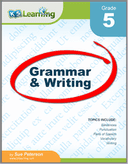
Download & Print Only $6.89
Plan then write
In these worksheets, students plan and then write an opinion essay. The planning framework includes an essay topic sentence, reasons, supporting details, counterarguments and conclusions.

These worksheets are available to members only.
Join K5 to save time, skip ads and access more content. Learn More
What is K5?
K5 Learning offers free worksheets , flashcards and inexpensive workbooks for kids in kindergarten to grade 5. Become a member to access additional content and skip ads.
Our members helped us give away millions of worksheets last year.
We provide free educational materials to parents and teachers in over 100 countries. If you can, please consider purchasing a membership ($24/year) to support our efforts.
Members skip ads and access exclusive features.
Learn about member benefits
This content is available to members only.
- Forgot Password?
Opinion Why so much fuss about an eclipse?

Returning to Wooster, my hometown of 27,000 people in northeastern Ohio, is usually an occasion not to worry about street parking or dinner reservations. But on April 8 — thanks to the region’s position in the path of the total solar eclipse — I’ll be among the throngs of out-of-towners donning funky glasses to watch the sun disappear behind the moon’s shadow and experience eerie darkness at 3:15 in the afternoon.
For the small towns from Texas to Maine in the path of totality, next week’s celestial event will be their moment in the sun, while also out of it. One Texas judge has already declared a state of emergency in anticipation of Bell County’s population of about 400,000 doubling or tripling in the days leading up to the eclipse. Three school districts in the county have called off classes for the day. And if past is precedent, it’s not just humans who will behave strangely: As Carolyn Y. Johnson recently reported in The Post, we could see swarms of fireflies alighting during the day or giraffes spontaneously galloping around their zoo exhibits.
Maybe you don’t plan to be among the solar pilgrims battling highway gridlock next week. Maybe you are wondering if people have lost their minds. Why all the fuss about a predictable alignment of the Earth, moon and sun? Aren’t there more pressing concerns with a pending presidential election, war in Ukraine, famine in Gaza and climate crisis?
Here’s a reason to give in, at least a little, to eclipse-mania.

A few years ago, I traveled with my mother to the very southern tip of India, a place called Kanyakumari, where the waters of the Bay of Bengal, the Arabian Sea and the Indian Ocean meet. We stood before dawn among thousands of people dressed in red — pilgrims who had traveled far, some without shoes and some for hundreds of miles, simply to watch the sun break into the sky from that spot. As it rose, the crowd gasped, cheered, cried and clapped. Their reaction was as beautiful as the sunrise itself. I felt more connected to humanity than I have ever felt before or since.
What occurred to me in that moment is that the sun is the original rock star, the OG with main-character energy on Earth. Watching it rise and set, or more dramatically be eclipsed and then reemerge, is miraculous in part because it reminds us that the sun makes all life on the planet possible. The effect is naturally more profound when witnessed in an exceptional place or circumstance.
Post-pandemic, many of us feel less a part of our communities. In a polarized country and a war-struck world, we lack common cause. Amid this disconnection and alienation, a solar eclipse is an opportunity not only for awe, wonder and escape — but for binding ourselves to the past and future of humanity.
People have been looking up to the stars for answers for millennia, whether it was to know the will of their gods or to navigate their ships across unknown seas. The solar eclipse carried omens for the ancient Mayans and the ancient Greeks. We can only imagine what it might mean to our descendants in the future, or to the artificial intelligence overlords that might govern them. What we do know is that total eclipses will recur for the next half-billion years , and that as long as people inhabit Earth, these events will be a spectacle if only for their rarity.
Total solar eclipses happen about once every year to three years, but most are visible only from the poles or the middle of the ocean. From any specific location, they can be seen just about once every four centuries. They are one thing about the foreseeable future that, despite the dramatic technological and planetary changes ahead, will remain consistent with our past.
This is why a trip to see the eclipse will be a trip home even for those not raised in the path of this year’s totality. It will be a chance to be reminded of our place in the solar system and the cosmos — something that, no matter how stark our differences, we still share.
- Opinion | How to survive another Trump-Biden election April 4, 2024 Opinion | How to survive another Trump-Biden election April 4, 2024
- Opinion | I’m retired, and I still won’t let myself read in the daytime. Why not? April 3, 2024 Opinion | I’m retired, and I still won’t let myself read in the daytime. Why not? April 3, 2024
- Opinion | How No Labels was thwarted — and a disaster for democracy was avoided April 7, 2024 Opinion | How No Labels was thwarted — and a disaster for democracy was avoided April 7, 2024

- Share full article
Advertisement
Supported by
Guest Essay
Stephen Breyer: The Supreme Court I Served On Was Made Up of Friends

By Stephen Breyer
Justice Breyer is a retired associate justice of the United States Supreme Court and the author of “Reading the Constitution: Why I Chose Pragmatism, Not Textualism.”
Recently, the Supreme Court justices Sonia Sotomayor and Amy Coney Barrett spoke together publicly about how members of the court speak civilly to one another while disagreeing, sometimes vigorously, about the law. Considerable disagreements on professional matters among the Supreme Court justices, important as they are, remain professional, not personal. The members of the court can and do get along well personally. That matters.
In my tenure, this meant that we could listen to one another, which increased the chances of agreement or compromise. It means that the court will work better for the nation that it serves. And I wonder: If justices who disagree so profoundly can do so respectfully, perhaps it is possible for our politically divided country to do the same.
Sandra Day O’Connor was the first woman appointed to the court; Ruth Bader Ginsburg was the second. I remember being slightly surprised when, during a visit to meet with several European judges, they suddenly disappeared. Where had they gone? It seems they went off together to look for suitable women’s collars for their robes. They found some, and Justice Ginsburg wore them ever after.
At about the same time, Justice O’Connor reminded me that our chief justice, William Rehnquist, had decided that he, too, needed something distinctive on his black robe. Inspired by Gilbert and Sullivan’s “Iolanthe ,” he decided to enliven it with a few gold stripes on the sleeves. Justice O’Connor found at a European bookstall a picture of Lorenzo de’ Medici wearing similar stripes. She suggested that we send it to him with a special message from her.
We would do things together outside class. Chief Justice Rehnquist, Justice Anthony Kennedy, Justice O’Connor and I would play bridge with friends and spouses (often changing partners). Today, I gather that justices who do not always agree on legal results nonetheless agree to go to hockey games or play golf together. (Why hockey in Washington, D.C., where baseball, football and basketball abound? Perhaps they just like hockey.)
As is fairly well known, Justice Ginsburg and Justice Antonin Scalia loved opera and became great friends. They even persuaded Justice Kennedy and me to take part in a Washington Opera performance of “Die Fledermaus,” provided, of course, that we simply sat onstage on a sofa and never opened our mouths. Justice Scalia had a good musical voice, however; he, law clerks and other justices would sometimes sing at the court, joined by Chief Justice Rehnquist, as well as by a friend of Justice Scalia who was a fine pianist and loved Cole Porter.
Justice Scalia and I would talk to students in high school or law school and other audiences about the court. It was obvious to those audiences that while we did not share basic views about how to interpret difficult statutory and constitutional phrases, we were friends.
Certain unwritten rules helped to smooth over differences and maintain good personal relations among court members. At conferences when we discussed cases privately, we proceeded in order of seniority, and no one would speak twice until everyone had spoken once. Thus, everyone could be fairly sure that he or she would have a chance to speak before minds were definitely made up. (This rule helped me, for I was the most junior justice for 11 years.)
Once all had spoken, we would discuss the case, back and forth. But one quickly learned that it did not help to say “I have a better argument than you.” Much better to listen to what others say and to find in their points of view material for working out an agreement or perhaps a compromise.
Chief Justice Rehnquist generally did not approve of jokes made during the business portion of the conference, though I admit I once told him while we were having coffee, after having recently nearly lost a majority on what we thought initially would be a unanimous opinion, “I have discovered how to get five people on a single opinion.” “How?” he asked. “Start with nine,” I replied.
In any event, agreement or disagreement, joke or no joke, in my 28 years on the court I did not hear a voice raised in anger in that conference, nor were snide or personal remarks ever made. The discussion was professional, disagreements reflected legal differences on the merits, and the justices tried to find ways to reach court agreements.
Justice O’Connor maintained that a highly important informal court rule was this: You and I may disagree strongly in respect to Case 1, but that fact has nothing to do with our positions in respect to (not legally related) Case 2, where we may be the strongest of allies. That is, no horse-trading.
After conference we would have lunch, often talking about sports or trading so-called jokes and other nonlegal matters. I remember once saying to Chief Justice Rehnquist that I thought it amazing that we were about to have a pleasant lunch when just 20 minutes before at conference we strongly disagreed about applicable law. His reply suggested that he thought only a short time earlier that half the court thought the other half had lost its mind.
What works for nine people with lifetime appointments won’t work for the entire nation, but listening to one another in search of a consensus might help.
Stephen Breyer is a retired associate justice of the United States Supreme Court.
The Times is committed to publishing a diversity of letters to the editor. We’d like to hear what you think about this or any of our articles. Here are some tips . And here’s our email: [email protected] .
Follow the New York Times Opinion section on Facebook , Instagram , TikTok , WhatsApp , X and Threads .

IMAGES
VIDEO
COMMENTS
I call it 2x2e: grading two papers in a sitting at least twice a day. When you only require yourself to grade two essays in a given moment, you tame the daunting tyranny of the stack. Dodging that pressure also helps you be more present for each essay, and students can certainly see the difference between thoughtful and rushed feedback.
Meanwhile, while fewer faculty members used AI, the percentage grew to 22% of faculty members in the fall of 2023, up from 9% in spring 2023. Teachers are turning to AI tools and platforms ...
OPINION WRITING CRITERIA TO ADDRESS. 1. Identify the Audience: Speak Clearly. Writing is about language and language is about communication; students should understand that we do not write in a vacuum. The purpose of an essay, letter, or any other form of writing we care to name, is ultimately to be read.
Body Paragraph 3. Supporting argument. Example. Explanation. A linking sentence to the conclusion. Conclusion paragraph. Summary of the entire paper. A conclusive sentence (the bigger picture in conclusion) If you need some help, leave us a message ' write my essay cheap ' and we'll help.
First, teach WHAT Opinion Writing is. When you begin your opinion writing unit, you of course need to start with teaching them what it is. You will be showing them the framework of an opinion writing piece. First, create an anchor chart (or use one provided to you in my ELA units). Then, as you explore texts, examples, and activities, you can ...
Tips for Teaching Opinion Writing. 1. Read Opinion Writing Mentor Texts. Before you can ask your students to write in a genre that is new to them, you must first immerse them in it. So to begin your unit, you'll want to share examples of opinion writing with your students. These mentor texts provide students with excellent examples of opinion ...
Lesson Plans for Writing an Opinion Statement. Day 1: Teach State an Opinion. Day 2: Use Sentence Frames to State an Opinion. Day 2: More Practice with Stating an Opinion. Day 4: Even More Practice Stating an Opinion. Day 5: Practice Writing Opinion Statements. Samples of Opinion Writing from Students.
Learn how to write an opinion essay. Hi kimmie, Thanks for your question. In academic and formal writing, there is a general preference for precision over vagueness, so generally speaking it's better to avoid this usage of so and thing and use more precise and academic terms when they are available (e.g.Therefore, the first factor/issue to consider is ...
• Revise useful vocabulary for writing an opinion essay. • Learn useful techniques for planning your own essay. • Evaluate two examples of a Writing Part 1 essay. • Practise and evaluate your own answer to a Writing Part 1 task. Review: Writing Part 1 . The B2 First for Schools Writing paper has two parts. Part 1 has only one task ...
Teaching opinion writing to your 3rd, 4th, or 5th grade students soon? Use the sentence starters and paragraph frames below in your lessons to help students structure their writing, use transitional words, stay on topic, and support their opinions. Templates like the examples below are a great way to introduce opinion writing.
a be photocopied for classroom use. 4 b uc Calins and Colleagues from the eachers College eading and Writing roect. riting Pata Perorance eent and Learning Progreion Grade einemann: ortsmouth, . * Elaboration and Craft are double-weighted categories: Whatever score a student would get in these categories is worth double the amount of points.
Writing Pathways: Performance Assessments and Learning Progressions, rades -8 (einemann Portsmouth N). Rubric for Opinion Writing—Fifth Grade Grade 3 (1 POINT) 1.5 PTS Grade 4 (2 POINTS) 2.5 PTS Grade 5 (3 POINTS) 3.5 PTS Grade 6 (4 POINTS) SCORE STRUCTURE Overall The writer told readers her opinion and ideas on a text or a topic and helped ...
An opinion would be assuming that everyone should feel the same way. For example, "Ice cream is by far the best food on earth". An opinion piece without any facts to back it up is likely to be less convincing and less effective. Finding a middle ground between the two is important to write an effective opinion piece.
Opinion essays, or persuasive writing, require that writers — of any age — present opinions on a specific topic. They usually begin with a strong opinion statement and then use supporting examples and evidence to support the argument. This type of writing requires critical thinking, helps to develop writing skills, and, best of all, boosts ...
Look at a third-grade opinion rubric. Select a topic and write three short essays about it. Write one essay that clearly qualifies as an excellent essay; one that meets the requirements of a good essay, and one that is a poor essay. This will not take long because third-grade essays are usually not very long. 2.
49 Opinion Writing Prompts for Students. One of the most common essay types is the opinion, or persuasive, essay. In an opinion essay, the writer states a point of view, then provides facts and reasoned arguments to support that viewpoint. The goal of the essay is to convince the reader to share the writer's opinion.
Opinion/argument writing includes speeches, editorials, reviews, proposals, letters, advertisements, and any sharing of a discrete opinion. Writing an argument requires sharing an opinion "persuasively" and then documenting the argument with informational text validating and verifying the position taken.
analytical opinion/argument writing rubric Writing Standards: Grade 4, Standard 1 (W.4.1) Write opinion pieces on topics or texts, supporting a point of view with reasons and information. EXAMPLE: Writing Standards: Grade 4, Standard 4 (W.4.4) Produce clear and coherent writing in which the development and organization are
As fifth grade students transition from elementary school to middle school, they frequently become more adept at expressing their own thoughts and ideas—and in many cases, also even more eager to do so. You can nurture this important skill in your students with our set of 30 5th-grade opinion writing prompts.
Are you ready to write about your opinion? This series will lead you through all of the important steps to writing an opinion piece! In episode 1, you'll lea...
Lesson 4: OREO Writing Lesson Plan and Resources. Overview: Students will use the OREO strategy to outline their opinion paper. Outlines will include the students opinion statement, 3 reasons, and an example or detail for each reason. W.3.1: Write opinion pieces on topics or texts, supporting a point of view with reasons.
Plan then write. In these worksheets, students plan and then write an opinion essay. The planning framework includes an essay topic sentence, reasons, supporting details, counterarguments and conclusions. Worksheet #1 Worksheet #2 Worksheet #3 Worksheet #4 Worksheet #5 Worksheet #6. Worksheet #7 Worksheet #8 Worksheet #9 Worksheet #10.
Transitions Opinion Clues I think I believe I feel In my opinion My favorite The best I strongly believe From my point of view It's my belief Based on what I know I am convinced Speaking for myself I know you will have to agree that I am confident that First/second/third First of all Next After that Additionally Equally important
When students respond to each other's writing, it's often more helpful to the responders than the receivers, writes Patricia A. Dunn. Even before complications wrought by AI, faculty members and students alike have often dreaded college writing assignments—students because of painful past histories with the process and faculty because of time-consuming, often-frustrating, grading ...
Elite College Admissions Have Turned Students Into Brands. Ms. Bernstein is a playwright, a writing coach and an essayist in Brooklyn. "I just can't think of anything," my student said ...
Maxim Shemetov/Reuters. To the Editor: Re " The West Still Hasn't Figured Out How to Beat ISIS ," by Christopher P. Costa and Colin P. Clarke (Opinion guest essay, April 1): Two clear ...
A total solar eclipse is not something that you see — it's something that you experience. You can feel the temperature around you begin to drop by as much as 15 degrees over the five to 10 ...
When I Became a Birder, Almost Everything Else Fell Into Place. Mr. Yong is a science writer whose most recent book, "An Immense World," investigates animal perception. Last September, I drove ...
Watching it rise and set, or more dramatically be eclipsed and then reemerge, is miraculous in part because it reminds us that the sun makes all life on the planet possible. The effect is ...
Justice Breyer is a retired associate justice of the United States Supreme Court and the author of "Reading the Constitution: Why I Chose Pragmatism, Not Textualism.". Recently, the Supreme ...